- 15 Interesting Facts About Cats That You May Not Have Known
- We Tried JustFoodForCats Fresh Cat Food: JustCats Review
- Moving Into a New Home? Help Your Cat Adjust With These Tips
- 5 Essential Tips for Adopting Your First Cat: What New Cat Owners Need to Know
- PetLibro Pet Drinking Fountain Review: We Tried a Water Fountain for Cats!


Wildernesscat
A happy, healthy life for your adventurecat!

Traveling with Cats: Motion Sickness and How to Solve It
Last Updated on February 1, 2020
Whether you’re setting out on a cross-country roadtrip with your cat, just need to take your cat on a quick car ride to the vet, or simply like cruising the streets with your cat in the backseat, there’s one thing that’s sure to ruin the drive.
When your cat has motion sickness, it’s not a pleasant experience for any of the passengers- especially if the sickness manifests in vomiting or diarrhea. Rather than lining your car with plastic and hoping for the best, let’s get to the root of the problem, and find out how we can solve it.
6 Signs your cat has motion sickness
- Loud and frequent meowing
- Vomiting or diarrhea
- Rapid breathing
- Frequent urination
- Excessive lip licking
Why do cats get motion sickness?
The vast majority of cases of motion sickness in cats are caused by a common culprit. Anxiety. If your cat wasn’t raised going on frequent car trips, it makes sense that this different experience could make them panic and feel anxious. Many cats are extremely sensitive to change, and riding in the car usually isn’t a day to day occurrence. While your cat’s anxiety may seem like a tough obstacle to overcome, if you’ve got a bit of patience and perseverance, you should soon be on your way towards smooth and stress free car rides.
How to get rid of your cat’s anxiety- making car rides the norm.
Some people only pull out the carrier and take their cats in the car when they need to bring them to the veterinarian, which is a stressful experience on its own. Such practices cause your cat to associate the car ride itself with the negative experience of the vet visit. Rather than trying to avoid the stress by making car rides even more infrequent, go against your first instinct, and take your cat out more often. Don’t always make the destination the vet’s office. Make it someplace fun; go to a park if your cat enjoys exploring the outdoors. You don’t even need a destination. Let your cat know that sometimes, a car ride is just that, and there will be times when you just end up at home again.
Take it slow and start indoors.
The very first step is to ensure that your cat feels cozy and at home in their carrier. At home, set up your cat’s carrier as a relaxing place to take a nap, a safe haven. When your cat goes inside on their own, offer rewards. Feed your cat near the carrier so they know it’s not something to be afraid of. This simple step can do wonders for reducing your cat’s anxiety on the road.
Once your cat sees their carrier as a comforting and familiar object, you may move to your vehicle.
Start with short sessions, in which you simply sit in the vehicle with the engine running, allowing your cat to become comfortable with the vehicle surroundings and new sounds. As soon as your cat accepts this environment, continue to push the boundaries and start taking your cat along on brief car rides. These can be as short as down the driveway or around the block. Slowly extend these trips, and maintain consistency by keeping them regular and frequent. If you’re patient and take this process slowly enough, much of your cat’s travel anxiety will be dissipated by the increased familiarity of travel.
Extra Tips:
- Place a blanket or shirt with a familiar scent on it within your cat’s carrier. Your own unwashed shirt will work great.
- Spray Feliway in your cat’s carrier or in the car. Feliway is a synthetic replica of feline pheromones, often used to reduce stress and anxiety in cats.
- Keep your car cool. An overly hot car often adds to a cat’s stress.
- Don’t blast the music. Loud music can just make the experience more disturbing. Quiet and relaxing music can help to soothe your cat’s anxiety, though.
- If your cat is known for throwing up in the car, abstain from feeding your cat for 12 hours before the car trip if it’s going to be a short one. If you must feed your cat, lay down a blanket and line your cat’s carrier in order to reduce the damage that will be done.
Is there anything I can give my cat for motion sickness?
If this acclimation process isn’t enough and your cat is still struggling with motion sickness, or you need to take your cat on an emergency car ride and don’t have time to go through the steps, there are a variety of supplements and drugs that may help make the trips go more smoothly.
Small doses of OTC antihistamines such as Dramamine, Bonine, and Benadryl may help with your cat’s motion sickness. Generally speaking, 10-12 mg doses of these drugs should be safe, but the dosage will vary depending on your cat’s weight and other potential factors. Consult your veterinarian for complete dosing instructions and recommendations.
In addition to these drugs, here are some natural and herbal treatments for motion sickness in cats:
Happy Traveler
Happy Traveler chews contain Valerian, German Chamomile, L-Tryptophan, and St. Johns Wort as active ingredients, herbs known to be naturally calming and helpful with anxiety.
Description from their website:
HomeoPet Travel Anxiety

Homeopathic medicine provides relief for: Motion sickness, fear of travel including cars, boats, trains, and airplanes/flying. Vomiting, drooling, panting, restlessness and unwanted behavior can be helped with this fast acting, non-sedating liquid.
Vetri-Science Composure Chews
Composure™ chews for cats are a calming supplement designed to promote relaxation during stressful situations. Examples: Your cat is headed to the vet. You had a new baby. You are having guests over for the holidays. You heard there’s about to be a thunderstorm. Whenever your cat is stressed, calming chews offer positive support. Three main ingredients work together to support relaxation without affecting your cat’s energy levels or personality. The Colostrum Calming Complex™ BiopeptideBlend supports stress reduction and cognitive function; L-Theanine helps the body produce other amino acids to bring specific neurotransmitters back into balance; and B vitamins (thiamine) affect the central nervous system to help calm anxious animals. No herbals used.
Bach Rescue Remedy for Pets
Rescue Remedy Pet is a combination of 5 Bach Flower Remedies to help your pet deal with stressful situations such as: going to the vet, the groomer, thunderstorms and during fireworks. We have heard fantastic stories from people giving Rescue Remedy to their dogs when having seizures. Rescue Remedy Pet is preserved in Glycerin and comes in two sizes 10 & 20 ml.
Travel doesn’t have to be stressful anymore.
Motion sickness can ruin a trip for humans and cats alike, but if properly managed, it no longer has to. More and more cats are joining their human guardians on road trips and daily outings, and this increased popularity is sparking more research and innovative solutions for treating and managing feline motion sickness. We want to hear you and your cat’s stories- what has and hasn’t worked during your car rides together. What do you recommend?

Related Posts

- ← 5 Best Wet Cat Foods for Urinary Health – The Key to Preventing Urinary Tract Disease
- Is Organic Catnip Better for Cats? →
Cats and Motion Sickness
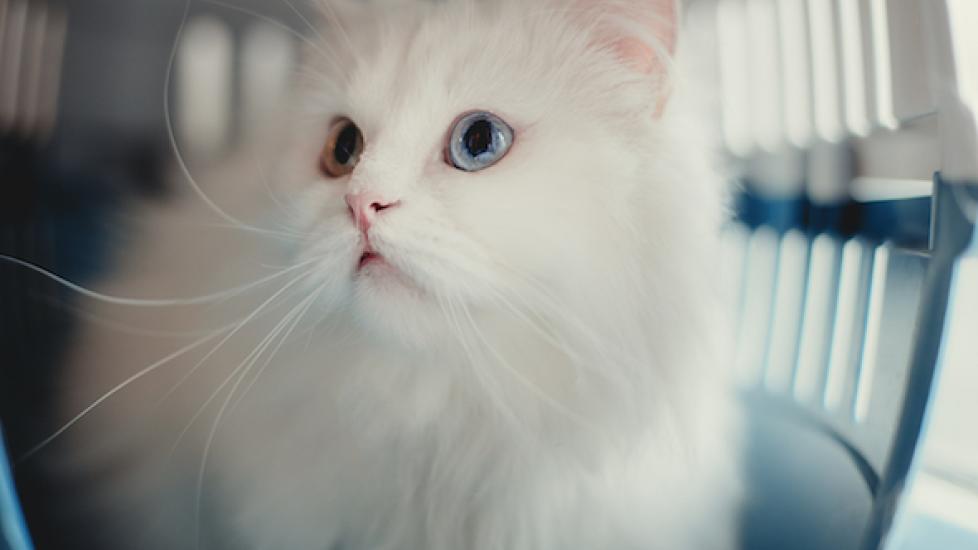
Gastrointestinal Distress Related to Motion in Cats
Humans are not the only species to get car sick. Cats also get a queasy stomach when traveling in the car (or even by boat or air).
Symptoms and Types
Cats show their uneasiness in various ways. The first signs of motion sickness may be:
- Excessive drooling ( ptyalism )
- Crying out in distress
- Immobility, or acting afraid to move
- Vomiting or regurgitation
- Urinating or defecating
There are several potential causes of motion sickness in cats. One possible cause of motion sickness can be emotional (behavioral), and linked to a bad travel experience in early life. Many cats feel insecure when taken out of their indoor environment infrequently.
Once neurologic, behavioral and other causes of vomiting are ruled out, the diagnosis of motion sickness can be easily made by the cat's veterinarian. The history of the cat's reaction to traveling usually points to the problem.
Treatment of this condition may be as simple as making your cat familiar with going for rides in the car. If time and training do not help the situation, various medications are available. Antihistamines (e.g., diphenhydramine) have a sedative action to slightly calm the pet during travel, as well as to reduce drooling. Other over-the-counter (OTC) medications that may be useful include meclizine and dimenhydrinate. These drugs don’t cause sedation, but can reduce nausea and vomiting.
Ginger is a holistic treatment used for nausea. It can be found in pill form (in health food stores), or even in cookie form. Ginger snaps and pills reportedly calm a nervous stomach when given about 30 minutes to an hour before travel. Consult with your veterinarian before feeding ginger to your cat in any form, to be sure that there are no indications that the ginger would be harmful to your cat, and to make sure that you are giving your cat the appropriate amount. In severe cases, stronger sedative drugs such as acepromazine may be prescribed.
A veterinarian should be consulted before any drugs are given (either OTC or prescription) just to be sure the cat is healthy, the dosage is correct, and that the medication won’t harm the cat.
Living and Management
Providing a safe, comfortable environment for your cat may lead to a better overall attitude toward travel. Opening the windows in the car slightly may help reduce air pressure inside the vehicle and allow for better ventilation. No food should be given for a few hours prior to getting in the car. Toys may help distract and entertain a high-strung cat. Taking frequent breaks may also help on long trips.
Time and acclimation may go a long way to prevent motion sickness. You may need to stock up on certain medications to help calm your cat if and when it gets nervous. Your veterinarian can suggest safe and effective drugs to ensure that travel goes smoothly each and every time.
Image via Shutterstock
Help us make PetMD better
Was this article helpful?
Related Articles

Subscribe to Our Newsletter
Sign up for weekly pet health tips and insights from our veterinarians.
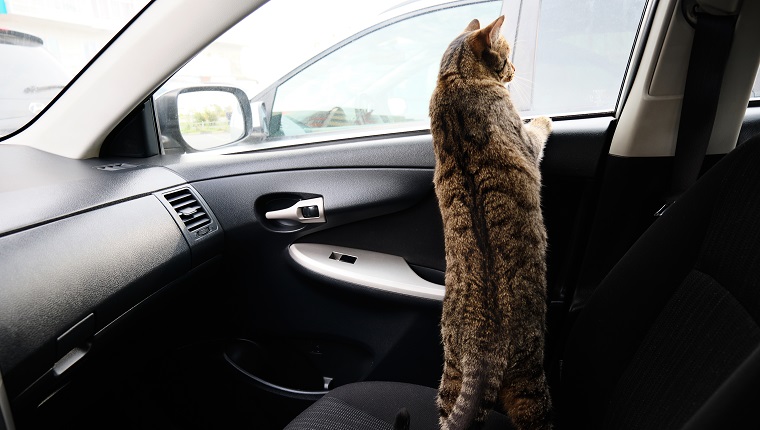
Motion Sickness In Cats: Symptoms, Causes, & Treatments
By Phillip Mlynar
Motion sickness in cats is a medical condition that can make a cat feel queasy when traveling in a car. It’s quite common, and the condition can be brought on by stress and anxiety.
Attempting to make your cat as comfortable as possible while traveling by car is often a key factor in overcoming the condition.
If you see signs that your feline might be suffering from sickness when traveling, then you must consult your veterinarian for a proper diagnosis and advice. Here’s what you should know about the symptoms, causes, and treatments of motion sickness in cats.
Symptoms Of Motion Sickness In Cats
Motion sickness in cats can bring on a range of symptoms. Some of the most common symptoms include:
- Seeming restless
- Meowing a lot
- Licking lips excessively
- Urinating while traveling
Causes Of Motion Sickness In Cats
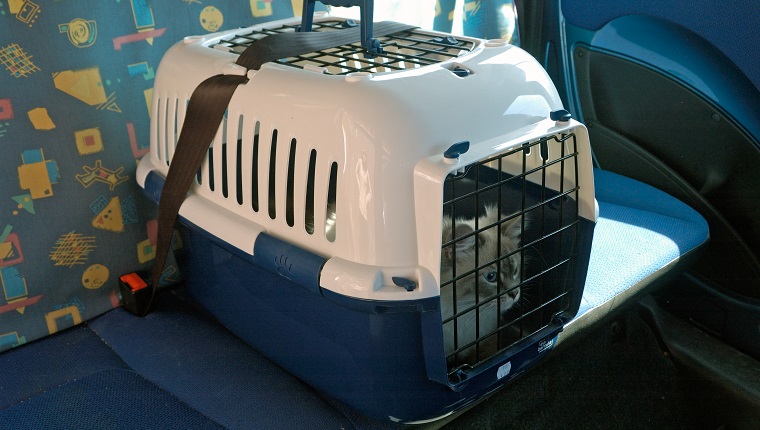
The cause of motion sickness in cats is often accredited to stress and anxiety.
In some cases, a negative early experience with traveling can cause a cat to suffer from frequent bouts later in life. Additionally, indoor cats might feel anxious and uneasy when they are taken outside for travel purposes.
Veterinary Treatments
If you worry that your cat is suffering from motion sickness, then your veterinarian will want to rule out any other underlying conditions that may be causing similar symptoms first.
In some cases, certain medicines can help manage the condition. For example, antihistamines can be used in a sedative fashion to help cats relax and reduce sickness. Additionally, certain over-the-counter medicines can help to lessen any vomiting and nausea.
As always, if your vet prescribes your kitty any medicine, then it is vital that you stick to the precise dosage, frequency and application instructions and complete the full course of medication.
In general, one of the most effective ways to overcome this condition is to make your cat feel more at ease with traveling . Make sure their cat carrier is large and comfortable enough, and start out by taking shorter trips before building up to any longer periods of travel.
In some cases, keeping a car window open can also help to reassure cats who experience sickness while traveling.
Does your cat ever suffer from motion sickness? How do you help them relax while you travel? Tell us all about it in the comments below.
Phillip Mlynar spends his days writing about pets, music, and craft beer (and sometimes the overlap between them). He's won numerous awards at the annual Cat Writers' Association Communication Contest, some of which are proudly on display at his local dive bar.
Share article

Prednisone For Cats: Uses, Dosage, & Side Effects

5 Streaming Shows To Entertain Your Cat

5 Reasons A Mother Cat Might Abandon Or Reject Her Young

7 DIY Cat Food Puzzle Toys That Will Keep Your Kitty’s Brain Active

50 Funny Cat Memes

Apoquel for Cats: Uses, Dosage, & Side Effects
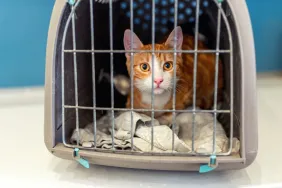
FDA Approves Drug To Calm Cats During Vet Visits

Free-Roaming Cats Pose a Threat to Wildlife and Themselves
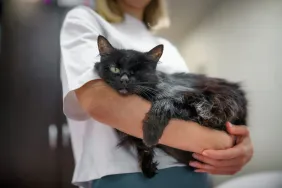
How to Care for a One-Eyed Cat
Free Shipping on Orders $30+

Motion Sickness in Cats: Symptoms and Ways to Help Relieve It
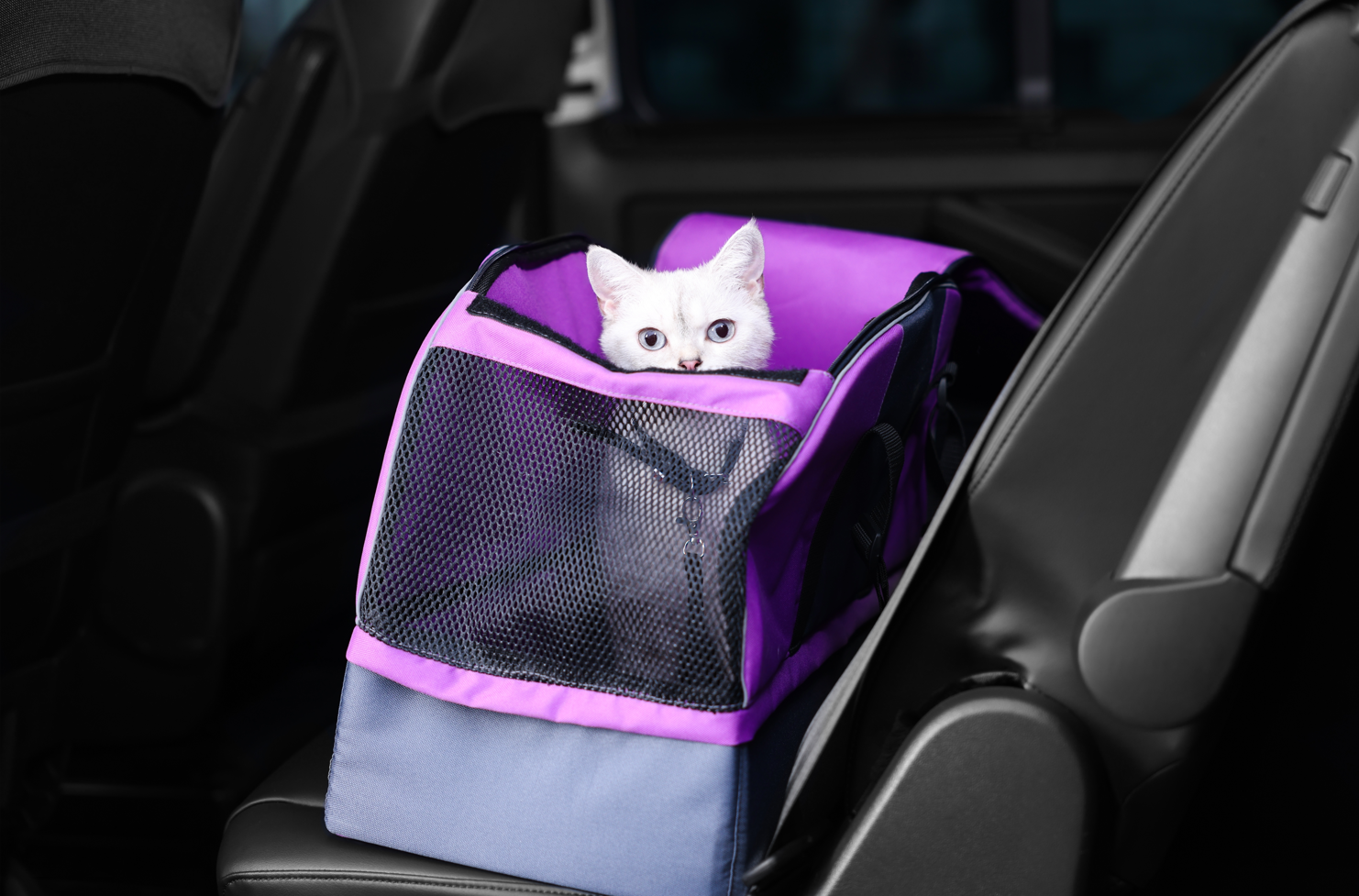
May 24, 2023
Does your cat start meowing nonstop when you need to bring them to the vet? Maybe your feline friend leaves behind some unpleasant “gifts” every time they ride in the car. Motion sickness in cats is a common issue many cats face, especially when they aren’t used to traveling. So how can you keep your furry friend from making your car their personal barf bag?
Does Your Cat Get Motion Sickness?
If you don’t bring your cat on many car rides, they likely stress out when the time finally comes. When your cat only experiences a car ride a couple of times a year, especially to visit the vet, it doesn’t seem like a very fun time.
Not only is your cat not used to riding in a vehicle, but they associate it with a stressful experience. This stress builds, and your precious kitty starts to get anxious about leaving the safety of home. Your cat might also dislike being enclosed in a crate during the car trip, adding to their stress level.
It becomes a cycle. Your cat doesn’t like riding in the car, starts to feel nervous, and gets sick. Then, your cat starts to associate the car with feeling sick, stresses out, and proceeds to vomit.
For some cats, an issue with the inner ear could be to blame. The inner ear connects to the part of the brain stem that triggers vomiting, and if it’s damaged, it sends altered signals to the brain. It also contains the vestibular system, which is responsible for coordination and balance. Depending on the message, your cat’s brain could interpret sensations differently, for example, spinning, leading to nausea.
Signs Your Cat Has Motion Sickness
If you’ve ever experienced motion sickness, you may recognize several of these signs cats experience when feeling icky in the car. (Except you probably don’t do much loud meowing.)
- Restlessness, frequent pacing
- Excessive lip licking
- Increased drooling
- Inactive, overly tired
- Excessive meowing or yowling

Need-To-Know Tips for Relieving Motion Sickness in Cats
If you think your cat might be dealing with an ear issue, it’s important to have your vet check things out first. It’s always essential to rule out any potential health problems that could be to blame. It’s also wise to ask your vet where they recommend you begin when it comes to easing your cat’s car fears.
If your cat’s ears get the all-clear, your vet can offer suggestions on how you can handle your cat’s stress about car rides. We’ll dig into these in a bit. But it’s also worth noting that your cat’s ears might be perfectly healthy but super sensitive.
Regardless, sometimes the mere fact that riding in the car makes your cat get sick could be enough to make them sick the next time. (Kind of like how people that hate to fly get sick before the plane even leaves the runway.)
Therefore, helping your pet keep calm and get used to the idea of car travel will go a long way to making the experience more pleasant for your feline pal (and you).
1. Give Your Cat Time to Get Used to Their Carrier
Cats aren’t always big fans of being in a pet carrier. So the first step is to take the necessary time to let your pet get used to being in one. Leave the carrier out and open at home with a few treats inside. Don’t just take it out right before a car trip.
Let your cat investigate at their own pace. Don’t close the crate’s door. Let your pet go in and out of the crate freely, offering them rewards and positive praise.
2. Desensitize Your Cat to Car Rides
Once your cat feels comfortable inside their carrier, simply place them in the car and give them a treat. Then sit in the car with them for a few minutes without going anywhere.
As your cat adjusts to this experience positively, you can take a short trip around the block. Once your cat is okay with this step, you can increase the distance and so on until your cat can handle longer rides.
3. Use Calming Products to Help Ease Stress
Talk to your vet about various products that can ease your cat’s stress. Feliway ® is one example of such a product that mimics a feline pheromone. You can mist the spray inside your cat’s carrier before a trip. There are also calming supplements for cats available. However, always discuss these options with your vet before giving anything to your pet.
Another option is to let your cat enjoy their favorite treat on the Neat-Lik Mat before getting in the car. The mat encourages licking, which helps stimulate the release of endorphins , helping your kitty stay calm. Enjoying their favorite yummy treat also makes them happy, which could lead to purring, which is another endorphin booster. (Your cat may also purr during the car ride because they use their purr to self-soothe .)
If your cat tends to experience gastrointestinal upset when riding in the car, you may want to wait and offer them the mat when you arrive at your destination. Sometimes, letting your pet travel on an empty stomach can help relieve potential upset. However, always provide fresh water. You can use a bottle that attaches to your cat’s carrier.
4. Stay Calm and Carry On
It’s no good trying to get your cat to stay calm if you start getting frustrated and lose your patience. Maintaining a calm and positive attitude is vital to helping your pet remain calm, cool, and collected.
5. Take a Potty Break Before the Trip
Whether you’re going on a quick ride or a long road trip with your cat , give them a potty break before the ride. If you’ll be traveling for over 6 hours, make sure to bring litter with you in a travel litter pan .
6. Play with Your Cat Before the Ride
Let your cat burn off some steam and release some energy before the ride with a rousing play session. Go through a few fun exercises with your cat before embarking on your journey. It also helps to offer your cat special toys that they only get when they go in their car carrier.
7. Create a Pleasant Experience in Your Car
Make sure to keep the air cool, play some classical music, and ensure your cat is comfortable. Adding one of your shirts or something else with your scent to your cat’s crate can also help them feel safe and secure.
8. Ask Your Vet About Medication
Sometimes, after trying everything, your cat might still get very anxious in the car. Your vet might be able to prescribe medication specifically for motion sickness if this is the case. Never give your cat medicine without first consulting with your vet.
Your vet might also suggest anti-anxiety medication if the problem is more about your cat’s stress levels. Regardless of the prescription, understand the proper dosing instructions and review them with the vet. For example, you might need to start some medications several days before your trip for them to work properly.
Yes, Cat-Friendly Car Rides Are Possible
With some patience, a few simple tips, and a visit to your vet, enjoying a pleasant car ride with your cat is in your future. To make the trip as stress-free as possible, take the time to let your cat adjust to the idea. (And don’t forget the FurDozer to banish your feline’s fur from your ride’s interior.)
Looking for more helpful tips and creative ways to bond with your feline friend? Check out the rest of the Neater Pets blog , and make sure to let us know about your cat-friendly car tricks.
Leave a comment
Please note: comments must be approved before they are published.
Your cart is empty
Subtotal:$0.00 USD
Have questions?
Shipping information
Order status
You are using an outdated browser. Please upgrade your browser to improve your experience.

- Choosing a cat
- Preparing for a cat
- Buying a kitten
- Adopt a cat FAQs
- What is our adoption fee?
- Our history
- Annual Review
- Meet the trustees
- Structure, governance and management
- Corporate partners
- CATS report
- Cats Protection blog
- Campaigning
- Financial assistance
- Grief and loss
- Cat Guardians
- Thinking about giving up your cat?
- Getting a cat
- Neutering, vaccinations and microchipping
- Pregnancy and kitten care
- Cat behaviour
- Behaviour Guide
- Lost, found and feral cats
- Cats and your family
- Home and environment
- Seasonal advice
- For vets and nurses
- Online learning
- Sponsor a cat
- Lottery and raffle
- Volunteering
- Volunteer opportunities
- Gifts in wills
- Pledge form
- Giving in memory
- Become a member
- Challenge events
- National Cat Awards
- Corporate partnerships
- Philanthropy
- The Cat magazine
- Fundraise for Cats Protection
- Work for us
- Online gift shop
- Shop with our partners
- Hide & Sleep®
- Find a shop
- Find the National Cat Centre
- Give us your feedback - we're all ears!
Travelling with your cat
Need to take your cat on a trip by car, taxi, or train? Or perhaps just need some advice on how to travel long distance with a cat? Read our guide on making travelling as easy and stress-free as possible for you and your cat.
Travelling with cats
Choosing the right cat carrier when travelling, how to get your cat used to a carrier for travel, what to bring when travelling with your cat, how to get your cat used to travelling in a car.
- Tips for travelling long distance with your cat
Travelling with your cat by taxi
Travelling with your cat by train or bus, how long can cats travel without going to the bathroom, what is motion sickness in cats.
We know that most cats find travelling stressful. They feel safe in a familiar environment and are not used to the different smells, noises and sensations of travelling in a vehicle. Even the sight of the pet carrier being taken out can stress some cats because they associate it with a sign of an upcoming trip.
It is best to only take your cat on trips if absolutely necessary, but some journeys, like going to the vet or moving to a new place, may be unavoidable.
If your cat gets very stressed when travelling, speak to your vet as they can discuss further options.
Find out more about spotting signs of cat stress .

One of the first things to prepare before travelling is to have a cat carrier that is safe and comfortable.
It should be well-ventilated and made of sturdy material such as plastic or metal wire that is also easy to clean in case of any accidents.
While some cats prefer being in small spaces when frightened, it’s important to choose a carrier that’s the right size for your cat, so they can stand up and move around if needed.
Learn more about how to choose and use a cat carrier .
To help your cat feel more comfortable, get them used to the carrier at least a few days before the trip. Place the carrier in a room where they like to relax and leave it open so they can explore and get to know it better in their own time. You can also put in their familiar blanket and add some treats.
For more nervous cats, a pheromone spray like FELIWAY® can be used inside the carrier around 15 minutes before going on a trip.
When going on a short trip with your cat such as to the vet, apart from having them in the carrier you can also bring their favourite toy or blanket.
For longer road trips, you should take the following to ensure your cat has everything they may need:
- cat carrier and soft bedding
- food and bottled water
- litter box, familiar litter and waste bags
- puppy pads (to line the carrier or place under a blanket)
- pet-safe cleaning wipes and disinfectant
If your cat hasn’t travelled in a car before, introduce them to travel gradually. Start with a short trip and go on a slightly longer journey the next time.
Your cat may be loud and meowing excessively. This is a sign of stress, but they should settle down eventually. You can show them attention and help them calm down a little by talking to them gently and reward them with treats when the journey is over.
Can I drive with my cat loose in the car?
To keep everyone safe, your cat should be kept in their carrier at all times when driving. Leaving your cat loose in the car can be a distraction and put you at risk of an accident. To secure the carrier, it’s best to put it on a backseat and fasten it with a seat belt.

Tips for travelling long distance in a car with your cat
- Book a routine vet check to make sure your cat is healthy for travel
- Unless you’ve been told otherwise by your vet, try to limit food for at least a few hours before the journey to avoid vomiting and reduce motion sickness
- Plan your journey route and breaks in advance. Don’t leave your cat unattended in the car, especially in hot weather . If travelling alone, limit to only essential short breaks and make sure inside the car is well-ventilated and the temperature is comfortable for your cat
- If possible, avoid travelling with your cat for more than four hours in a day and let them out in a room where they will spend the night. For longer journeys, aim to take regular breaks every two to four hours to give you a chance to check up on your cat
There may be situations when you need to go to the vet urgently or take your cat somewhere quickly, and if you don’t have a car, a taxi can be a good option.
As for taxis, whether or not you can travel with your pet depends on the taxi company or driver. Some companies may charge extra to bring a pet. Depending on your location, there may be a pet-specific taxi service in the area.
Before booking, make sure the taxi driver will accept travelling with pets. You will also need to keep your cat inside the carrier for the duration of the trip.
If you’re wondering whether you can take your cat on a train, you should know that in the UK each passenger is allowed to travel with up to two pets, free of charge.
If you want to take your cat on a bus, the bus driver may decide at their discretion whether you are allowed on with a pet, depending on how busy the bus is and whether there are other animals on board.
Other things to be aware of when travelling on a train or bus are the many different smells, unfamiliar faces, and other animals, all of which can scare your cat. You can try booking a ticket outside of peak hours and, if possible, find a quiet place during the journey. Do not leave your cat unattended, and keep the carrier close to you. Throwing a light blanket over the carrier can help prevent overstimulation but ensure there is adequate airflow.
When travelling by public transport, you should keep your cat in a carrier throughout the trip.
On average, cats with no underlying health issues urinate two to four times daily and poop about once a day.
However, being in an unfamiliar environment such as in a car is stressful for your cat so they might hold in their urge to go to the bathroom. But sometimes they are not able to hold it and will need to use the litter box right away.
If you notice that your cat suddenly becomes extremely loud and shows signs of distress or wanting to get out, it might be the time you will need to let them use the litter box. It’s advisable to avoid letting your cat in and out of the carrier frequently but, if needed, have the litter box ready next to them and let them use it once you stop for a break.

Motion sickness is a common occurrence in many cats. There can be several causes, but the most common cause of motion sickness in cats is anxiety and stress associated with travel. If your cat experiences this, you may notice the following symptoms:
- fast breathing or panting
- excessive lip licking and drooling
- increased vocalisation and meowing
- lethargy or inactivity
If you see any of these signs, you should let your vet know so they can do a physical exam to rule out any health issues or advise you on ways to manage your cat’s anxiety when travelling.
Although desensitising cats to travel can take some work and patience, over time your cat should become more comfortable when going on a trip.
Related topics
Foreign travel and cats
Moving home with your cat
Going on holiday without your cat

- Health Africa
- Explore Africa
- Safari Adventures
- Wildlife Getaways
- Culture and Heritage
- Food and Drinks
- Travel Stories
- Gear Reviews
- Packing Lists
- Travel Products
- Travel Tips
- Adventure Travel
- Budget Travel
- Family-Friendly Travel
- Solo Travel
Ultimate Guide: How to Travel with a Cat Stress-Free
Traveling with a cat can be an exciting adventure, but it can also come with its fair share of challenges. Whether you’re embarking on a road trip or hopping on a plane, ensuring a stress-free journey for both you and your feline friend is essential. That’s why we’ve put together this ultimate guide to help you navigate the ins and outs of traveling with a cat.
From planning and preparation to in-flight tips and hotel stays, we’ve got you covered with expert advice and practical tips to make your cat’s travel experience as smooth as possible. Discover how to get a pet passport, ensure your cat’s health and vaccinations are up to date, navigate airport security, keep your cat hydrated during travel, and even find reliable pet sitters while you’re away.
So, whether you’re a seasoned traveler looking to explore new destinations with your furry companion or a first-time cat traveler seeking guidance, this guide is your go-to resource for all things cat travel. Get ready to embark on an unforgettable journey with your beloved cat!
Table of Contents
Key Takeaways:
- Plan and prepare in advance for stress-free cat travel
- Get a pet passport for international travel
- Ensure your cat’s health and vaccinations are up to date
- Navigate airport security with ease
- Keep your cat hydrated and fed during travel
How to Get a Pet Passport for Your Cat
If you’re planning to travel internationally with your cat, it’s important to ensure they have a valid pet passport. This documentation is necessary to comply with the regulations and requirements of the country you’re traveling to. Obtaining a pet passport involves several steps and specific documentation, so it’s essential to start the process well in advance to ensure a smooth journey for your furry friend.
Gather the Required Documentation
When getting a pet passport for your cat, you’ll need to gather the necessary documentation. This typically includes:
- Proof of identification, such as a microchip or tattoo
- Proof of rabies vaccination and other required vaccinations
- A health certificate issued by a licensed veterinarian
It’s important to note that the specific requirements may vary depending on the country you’re traveling to. Research the destination’s pet import regulations or consult with a veterinarian who specializes in international pet travel to ensure you have all the necessary documents.
Visit the Veterinarian
Before obtaining a pet passport, schedule a visit to the veterinarian. They will ensure your cat is in good health and administer any required vaccinations or treatments. The veterinarian will also provide the necessary paperwork, such as the health certificate, which is a crucial part of the pet passport process.
Apply for the Pet Passport
Once you have gathered all the required documentation, you can apply for the pet passport. This is typically done through your country’s official animal health authority or another designated agency. Follow the application process, provide all the necessary documents, and pay any applicable fees. The processing time for a pet passport can vary, so be sure to apply well in advance of your travel dates.
By following these steps and ensuring your cat has a valid pet passport, you’ll be well-prepared for international travel with your feline companion. Remember to check the specific requirements of your destination and consult with professionals for any additional guidance.
Cat Health and Vaccination for Travel
When it comes to traveling with your cat, their health and well-being should be a top priority. Before embarking on your journey, it’s crucial to ensure that your feline friend is in good health and up-to-date on their vaccinations. This not only ensures their well-being during travel but also ensures compliance with airline and destination requirements.
It is highly recommended to schedule a visit to the veterinarian before your trip. This allows you to address any health concerns, obtain necessary vaccinations, and discuss options for managing any anxiety or stress your cat may experience during the journey. Your veterinarian will be able to provide guidance on the specific vaccinations your cat may need based on the destination and duration of your travel.
Preparing Your Cat for Air Travel
Air travel can be particularly stressful for cats, so it’s important to prepare them in advance. Familiarize your cat with their carrier well before the trip, allowing them to associate it with positive experiences such as treats or feeding. Gradually increase the time they spend inside the carrier to help them feel more comfortable in it.
Additionally, consider using calming aids such as pheromone sprays or natural remedies recommended by your veterinarian to help manage any anxiety or stress your cat may experience during the journey. Creating a calm and familiar environment for your cat during travel can go a long way in ensuring their comfort and well-being.
Traveling with your cat can be a wonderful experience, but it’s important to take the necessary steps to ensure their health and safety. By staying proactive and prepared, you can help make the journey as stress-free as possible for both you and your furry companion.
Navigating Airport Security with a Cat
When traveling with your cat, going through airport security can be a bit overwhelming. However, with proper preparation and knowledge of the TSA guidelines, you can ensure a smooth experience for both you and your furry companion. Here are some tips to help you navigate airport security with your cat:
- Use a secure carrier: The TSA requires that cats be transported in a carrier during the security screening process. Make sure your carrier is secure and meets the airline’s requirements for size and construction. This will help keep your cat safe and prevent any mishaps during the screening.
- Follow liquid restrictions: Just like with any carry-on items, there are limits on the amount of liquids you can bring through security. This includes any water or other liquids you may have for your cat. Be sure to check the TSA guidelines for specific restrictions and make arrangements to purchase water once you are through security if needed.
- Prepare for the security screening: When it’s time to go through security, you will need to remove your cat from their carrier and carry them through the metal detector while the carrier goes through the X-ray machine. It’s a good idea to use a harness on your cat for added security and to prevent them from escaping or getting scared.
Remember to stay calm and patient during the screening process. This will help keep your cat calm as well. If you have any questions or concerns, don’t hesitate to ask the airport staff or TSA agents for assistance. By following these guidelines, you can ensure a stress-free security screening with your cat.
Table: TSA Guidelines for Traveling with Pets
Keeping your cat hydrated during travel.
When traveling with your cat, it’s important to ensure that they stay hydrated throughout the journey. Adequate hydration is crucial for their well-being and comfort, especially during long trips. Here are some tips to help you keep your cat hydrated:
- Provide access to fresh water: Make sure to have a spill-proof water dispenser in your cat’s carrier or travel crate. This will allow them to drink whenever they feel thirsty without the risk of spills or leaks.
- Offer water breaks: During breaks or layovers, offer your cat small, frequent water breaks. This will help to replenish their hydration levels and prevent dehydration.
- Consider wet food or water-rich treats: If your cat is not drinking enough water during travel, you can try offering wet food or water-rich treats. This will provide additional hydration and also keep them satisfied during the journey.
Additionally, it’s important to manage your cat’s feeding times while traveling. Here are some tips for ensuring a comfortable and problem-free mealtime:
- Stick to a regular feeding schedule: Try to feed your cat at their usual meal times, even while traveling. This will help maintain their routine and prevent any digestive upsets.
- Avoid feeding too close to travel time: It’s best to avoid feeding your cat immediately before or during travel, as it can increase the risk of upset stomachs or motion sickness.
- Pack familiar and easily digestible food: Bring along your cat’s regular food to maintain familiarity and minimize the chances of digestive issues. Opt for easily digestible options that won’t cause any discomfort during travel.
Finally, when staying in a hotel or other accommodation, it’s essential to ensure the room is safe for your cat. Here are some considerations for cat-friendly hotel room safety:
- Inspect the room for potential hazards: Look out for open windows, loose wires, or toxic plants that could pose a danger to your cat. Take the necessary steps to eliminate or mitigate any risks.
- Create a comfortable space for your cat: Set up a designated area with their bed, litter box, and familiar toys. This will provide them with a sense of security and help them adjust to the new environment.
- Secure any potential escape routes: Make sure that windows and doors are securely closed to prevent your cat from accidentally escaping. Consider using door stoppers or placing a towel at the bottom of the door to ensure they can’t slip out.
By following these tips for keeping your cat hydrated, managing feeding times, and ensuring hotel room safety, you can make your cat’s travel experience as comfortable and stress-free as possible.

How to Deal with Cat Travel Sickness
Traveling with a cat can be an exciting adventure, but some cats may experience travel sickness, which can make the journey uncomfortable for them. To ensure a stress-free and enjoyable trip for your feline friend, here are some tips on how to deal with cat travel sickness .
Creating a Calm Environment
It’s important to create a calm and familiar environment for your cat during travel. Start by acclimating your cat to their carrier well in advance of the trip, allowing them to feel comfortable and secure inside. Additionally, consider placing a familiar blanket or item with their scent in the carrier to provide a sense of familiarity.
“Traveling with a cat can be an exciting adventure, but it’s crucial to prioritize their comfort and well-being. By taking steps to minimize travel sickness and create a calm environment, you can help ensure a stress-free journey for both you and your feline friend.”
During the journey, keep the carrier stable and avoid sudden movements or loud noises that may cause anxiety for your cat. If possible, choose a well-ventilated area with minimal distractions to reduce stress.
Consider Natural Remedies or Medications
If your cat experiences significant travel sickness, it may be beneficial to consult with your veterinarian about natural remedies or medications that can help alleviate their symptoms. There are herbal remedies and anti-anxiety medications available that can help calm your cat during travel, making the journey more comfortable for them.
Monitor Food and Water Intake
It’s essential to monitor your cat’s food and water intake before and during travel. Avoid feeding your cat a large meal right before the journey as it may increase the likelihood of travel sickness. Instead, provide small, frequent meals leading up to the trip to keep their stomach settled.
When it comes to water, ensure your cat stays hydrated during the journey. Use a spill-proof water dispenser or offer small, frequent water breaks to prevent dehydration. However, be mindful that excessive water intake may lead to more frequent bathroom breaks, so find a balance that works for your cat’s needs.
By following these tips and tricks, you can help minimize cat travel sickness and create a stress-free travel experience for your feline companion. Remember to prioritize their comfort and well-being throughout the journey, ensuring a smooth and enjoyable adventure together.
Training Your Cat to Travel
If you’re planning to travel with your cat, it’s important to train them to make the journey as stress-free as possible. Whether you’re taking a short road trip or flying to a new destination, here are some tips to help you train your cat to travel:
- Introduce the carrier: Start by introducing your cat to their carrier well before the travel date. Place treats or toys inside to encourage them to explore and associate it with positive experiences.
- Gradually increase time spent inside: Once your cat is comfortable with the carrier, gradually increase the duration and frequency of their time spent inside. This will help them become familiar with the confined space and reduce anxiety during travel.
- Take short practice trips: Before embarking on a long journey, take your cat on short practice trips in the car. Start with just a few minutes and gradually increase the duration to help them adjust to the motion and sounds of travel.
- Provide comfort and familiarity: Place familiar items in the carrier, such as a blanket or toy with your cat’s scent. This will help them feel more secure and at ease during the journey.
- Use positive reinforcement: Reward your cat with treats and praise for calm behavior during training and travel. This will reinforce positive associations with the travel experience.
Remember, every cat is unique, and some may require more time and patience to adjust to travel. Be patient and consistent with your training efforts, and consult with your veterinarian if you have any concerns or need additional guidance. With time and practice, your cat can become a seasoned traveler, ready to explore new places with you.

How to Travel with a Kitten
If you have a kitten, it’s important to start their travel training early to ensure they become comfortable with the experience. Here are some additional tips specifically for traveling with kittens:
- Begin training at a young age: Start introducing your kitten to their carrier and the travel process as early as possible. This will help them become accustomed to it from a young age.
- Make it a positive experience: Use treats, toys, and praise to create a positive association with travel. Reward your kitten for calm behavior and gradually increase their exposure to different travel scenarios.
- Take shorter trips initially: Start with short car rides before embarking on longer journeys. This will allow your kitten to gradually adjust to the motion and sounds of travel.
- Ensure their safety and comfort: Make sure the carrier is secure and well-ventilated, with enough space for your kitten to move around comfortably. Use bedding or blankets to provide a cozy environment.
By starting early and providing positive experiences, you can help your kitten become a confident and relaxed traveler.
Stress-Free Vet Visits Before Travel
Before embarking on your travel adventure with your cat, it’s important to prioritize their health and well-being by scheduling a stress-free visit to the vet. This will ensure that your furry friend is up to date on all necessary vaccinations and that any potential health concerns are addressed before the journey. A vet visit also offers the opportunity to obtain any required paperwork or certificates for travel.
During the vet visit, you can discuss specific travel concerns with your veterinarian and seek their advice on ensuring a comfortable and safe journey for your cat. This may include recommendations for managing anxiety or motion sickness, as well as any additional health precautions to take based on your travel destination.
Additionally, consider grooming your cat before travel to minimize shedding and keep them comfortable throughout the journey. Brushing their coat and trimming their nails can help reduce the amount of hair and potential scratches during the trip. This not only keeps your cat looking and feeling their best but also makes it easier to keep their carrier clean and hygienic.
Lastly, microchipping your cat before travel is highly recommended. This small and painless procedure involves implanting a microchip under your cat’s skin, containing their unique identification number. In case your cat gets lost during the journey, a microchip greatly increases the chances of being reunited with them. Ensure that you update your contact information associated with the microchip so that you can be easily reached if your cat is found.
By prioritizing a stress-free vet visit, grooming your cat before travel, and microchipping them for added safety, you can ensure that your feline companion is well-prepared for the journey ahead. Taking these precautions will not only contribute to a more comfortable travel experience for your cat but also provide you with peace of mind throughout your trip.
How to Find Pet Sitters While Traveling
When planning a trip without your cat or participating in activities where you can’t bring them along, finding reliable pet sitters is crucial. Whether it’s a family member, friend, or professional pet sitter, ensuring your cat is in safe and caring hands will give you peace of mind and allow you to fully enjoy your trip.
If you’re staying in a hotel, it’s important to choose cat-friendly accommodations that offer pet sitting services. Many hotels now cater to pet owners and provide pet sitting options, allowing you to explore and enjoy your destination without worrying about your furry companion.
Another fantastic option is to opt for cat-friendly vacation rentals. These rentals often come equipped with pet sitting services or can provide recommendations for trusted pet sitters in the area. This way, you can have peace of mind knowing your cat is being taken care of while you’re away.
In addition to checking with hotels and vacation rentals, you can also explore local pet sitting services in the area you’ll be traveling to. Many professional pet sitters offer in-home visits or even overnight stays, ensuring your cat receives the care and attention they need in the comfort of their familiar environment.
Table: Comparison of Pet Sitting Options
Remember to discuss your cat’s specific needs, routines, and any medical conditions with the pet sitter before your trip. Providing detailed instructions and leaving contact information will ensure your cat receives the best care possible.
By taking the time to find reliable pet sitters, you can confidently travel and explore knowing your beloved feline friend is in good hands.
Flying with a Cat In-Cabin
If you’ve decided to fly with your cat in-cabin, there are specific considerations and preparation steps to follow. By following these guidelines, you can ensure a smooth and stress-free flying experience with your feline companion.
- Choose the right airline: Not all airlines allow cats in the cabin, so it’s important to research and select an airline that accommodates in-cabin pet travel. Check their pet policies, restrictions, and requirements before booking your tickets.
- Size-appropriate carrier: Invest in a well-ventilated carrier that meets the airline’s size requirements. Your cat should be able to stand, turn around, and lie down comfortably inside the carrier. Ensure the carrier is secure and sturdy, with no chance of escape during the flight.
- Acclimate your cat to the carrier: Help your cat get accustomed to their carrier by gradually introducing them to it before the trip. Place treats, toys, and bedding inside the carrier to create a positive association. Encourage your cat to spend time in the carrier voluntarily to reduce anxiety during travel.
- Essential supplies: Pack necessary supplies such as food, water, litter, and any medication your cat may need during the journey. Ensure you have enough to last the entire trip, including any layovers or delays that may occur.
- Security checks: Be prepared for security checks at the airport. Follow TSA guidelines and carefully follow instructions from airport personnel. You may be required to remove your cat from the carrier and carry them through the metal detector while the carrier goes through the X-ray machine.
Remember, flying with a cat in-cabin can be an enjoyable experience with proper planning and preparation. It’s important to prioritize your cat’s comfort, safety, and well-being throughout the journey. By following these tips, you can ensure a smooth and stress-free travel experience for both you and your feline friend.
Traveling with a cat requires careful planning and consideration, but with the right guidance and preparation, it can be a rewarding and enjoyable experience for both you and your feline companion. By following the tips and advice outlined in this cat-friendly travel guide , you can ensure a stress-free and comfortable journey, allowing you to create lasting memories with your cat while exploring new destinations.
Remember to pack all the necessary cat travel essentials , including a well-ventilated and secure carrier, food and water dishes, familiar bedding, and any required documentation or ID tags. It’s also important to prioritize your cat’s health and well-being by scheduling a pre-travel vet visit, keeping them hydrated during the journey, and managing any travel sickness or anxiety they may experience.
When traveling with a cat, it’s important to practice best practices for their safety and comfort. This includes acclimating them to their carrier and the travel process, training them to travel from a young age, and finding reliable pet sitters or cat-friendly accommodations when needed. By taking these steps, you can ensure a smooth and enjoyable travel experience for both you and your beloved feline friend.
How do I obtain a pet passport for my cat?
To get a pet passport for your cat, you’ll need to obtain the necessary documentation and ID tags. This includes following any specific requirements for the country you’re traveling to. Start the process well in advance to allow for any necessary vaccinations or tests that may be required.
How can I ensure my cat is in good health for travel?
Before your journey, schedule a vet visit to ensure your cat is in good health and up-to-date on their vaccinations. This not only ensures their well-being during travel but also complies with airline and destination requirements. Discuss any health concerns, obtain necessary vaccinations, and explore options for managing any anxiety or stress your cat may experience during the journey.
What are the TSA guidelines for traveling with a cat?
To navigate airport security with a cat, it’s important to understand the TSA guidelines for traveling with pets . This ensures compliance and minimizes potential issues. Additionally, deciding whether to use a harness or carrier for your cat during security screening is a personal choice that prioritizes your cat’s comfort and safety.
How do I keep my cat hydrated during travel?
Hydration is crucial for your cat’s well-being during travel. Provide access to fresh water throughout the trip and consider using a spill-proof water dispenser or offering small, frequent water breaks. Additionally, manage your cat’s feeding times to prevent upset stomachs. When staying in a hotel, ensure the room is safe with no potential hazards or escape routes.
What can I do to minimize cat travel sickness?
Some cats may experience travel sickness, which can make the journey uncomfortable for them. Take steps to minimize travel sickness, such as acclimating your cat to their carrier before travel, providing a comfortable and familiar environment, and considering natural remedies or medications to alleviate any nausea or anxiety.
How do I train my cat to travel?
Start by introducing your cat to their carrier and gradually increase the duration and frequency of their time spent inside. For kittens, start the training process early and make travel a positive experience. Help your cat adjust to new places, such as hotels or vacation rentals, to ensure their comfort and well-being.
What should I do before traveling with my cat?
Before traveling, take your cat for a stress-free vet visit. Ensure they are up to date on vaccinations, obtain necessary paperwork or certificates, and discuss any specific travel concerns. Consider grooming your cat before travel to minimize shedding and keep them comfortable. It’s also a good idea to microchip your cat and update their contact information in case they get lost during the journey.
How can I find reliable pet sitters while traveling?
If you can’t bring your cat along or have activities where they can’t join, find reliable pet sitters. This could be family, friends, professional pet sitters, or pet-friendly hotels or vacation rentals offering pet sitting services. Ensuring your cat is in safe and caring hands while you’re away will give you peace of mind and allow you to enjoy your trip.
What should I know about flying with a cat in-cabin?
If you’ve decided to fly with your cat in-cabin, follow specific considerations and preparation steps. These include choosing the right airline, understanding their pet policies, selecting an appropriate carrier, and acclimating your cat to the travel process. These tips will help make your flying experience with a cat as smooth as possible.
How can I make traveling with a cat stress-free?
Traveling with a cat requires planning and consideration, but with the right guidance and preparation, it can be enjoyable. By following the tips and advice outlined in this guide, you can ensure a stress-free and comfortable journey, creating lasting memories with your cat while exploring new destinations.
Uncover Secrets: How to Travel for Cheap – Your Guide to Budget Traveling
Discover the best time to travel to south africa, related posts.

Airport Medication Packing: New Security Guidelines Unveiled

What To Wear In The Enchanting Autumnal Beauty Of Lake Como In October?

Best Months to Visit South Africa: A Seasonal Guide

How Do I Handle Money When Traveling Internationally?

Packing Tips for Travel: Shirt Folding Techniques

Discover the Aromatic Delights of Thai Basil in Vietnamese Cuisine

Understanding the different herbs used in Vietnamese cuisine can enhance your dining experience

Vietnamese Coriander: A Refreshing Twist to Vietnamese Cuisine

Rice Paddy Herb: Adding a Zesty Lemon-Dill Flavor to Vietnamese Dishes

Exploring the Flavors of Vietnamese Herbs: Fish Mint, Vietnamese Balm, and more

15 Best Places To Visit In August In The U.S. in 2023 (SUMMER SPOTS!)

15 Best Places to Visit in FLORIDA in February 2024

15 Best Places to Visit in Europe in November 2023

15 Best Places To Travel in June 2023 in USA [Summer Picks!]
- African Beach Getaways
- African Food Adventures
- African Heritage Sites
- Health and Safety
- Top African Getaways
- Travel Destinations
- Travel Experiences
- Travel Gear and Packing
- Travel Resources
- Types of Travel
- Uncategorized
© 2023 travelhappygirl.com - The Happy Girl's Guide to Travel
Important Pages
- Privacy & Policy

Welcome Back!
Login to your account below
Remember Me
Retrieve your password
Please enter your username or email address to reset your password.
Motion Sickness in Animals
- For More Information |
Motion sickness is characterized by signs referable to stimulation of the vestibular and autonomic nervous systems, including excessive salivation and vomiting. Affected animals may also yawn, whine, or show signs of uneasiness and apprehension; severely affected animals may also develop diarrhea. Motion sickness is seen during travel by land, sea, or air, and signs usually disappear when vehicular motion ceases.
The principal causative mechanism involves stimulation of the vestibular apparatus in the inner ear, which has connections to the emetic center in the brain stem. The chemoreceptor trigger zone (CRTZ) and H 1 -histaminergic receptors are involved in this pathway in dogs but apparently are less important in cats. Recent evidence has revealed that the neurokinin 1 substance P receptors (NK1) in the emetic center play a major role in motion sickness in both dogs and cats and are more important than the receptors in the CRTZ. Fear of the vehicle may also become a contributory factor in dogs and cats that develop a conditioned response to the event; signs may be seen even in a stationary vehicle. In this situation, behavioral modification may be needed to eliminate this fear, or the use of drugs that provide a sedative effect may be needed.
In some cases, motion sickness can be overcome by conditioning the animal to travel. In others, anxiolytic and antinausea drugs can be used with good results. Antihistamines (such as diphenhydramine hydrochloride, dimenhydrinate, meclizine, and promethazine hydrochloride) prevent motion sickness, provide sedation, and inhibit drooling. The centrally acting phenothiazine derivatives (such as chlorpromazine, prochlorperazine, and acepromazine maleate) have antiemetic as well as sedative effects. Cats have no histamine receptors in the CRTZ; therefore, antihistamines are ineffective in treating motion sickness in this species. Motion sickness in cats probably is best treated with an alpha-adrenergic antagonist (eg, chlorpromazine) instead of a pure H 1 -histaminergic antagonist.
Maropitant, an NK1 receptor antagonist, is effective in treating motion sickness in dogs. NK1 receptors are located in the emetic center of the brain stem, which is the source most responsible for the vomiting and nausea of motion sickness. Blocking these receptors is more effective than inhibiting the CRTZ. Therefore, maropitant is probably the drug of choice to treat motion sickness in dogs. Another benefit is that treatment is given once daily. The drug is approved and available in tablet and injectable forms for use in dogs, while only the injectable form is approved for use in cats. However, cats can exhibit severe aversive and pain behaviors to subcutaneous injection. Cats should be 16 weeks old and dogs 8 weeks old before being administered maropitant.
Phenobarbital and diazepam can be used to produce a general sedative effect if anxiety is a problem. Oral administration of one of these drugs several hours before departure should reduce or eliminate the signs of motion sickness. (Also see Drugs Used to Control or Stimulate Vomiting in Monogastric Animals .)
For More Information
Also see pet health content regarding motion sickness in dogs and cats .

Motion Sickness in Small Animals: Pathophysiology & Treatment
Pathophysiology
The body detects motion through 3 sources: vestibular, visual, and proprioceptive input to the CNS. 1-3 Motion sickness can occur when there is conflicting or inconsistent input (vestibular, visual, or proprioceptive) processed within a multimodal sensory system whose function is to ascertain a patient's motion in relation to environment. 1,3
The nausea and vomiting associated with motion sickness is a result of overstimulation of the labyrinth (ie, inner ear) apparatus. The labyrinth has 3 semicircular canals, responsible for maintaining equilibrium. 1,3 Postural adjustments are made when the brain receives nerve impulses initiated by the fluid in canals. 1,3 Motion sickness occurs with acceleration in a direction perpendicular to the longitudinal axis of the body, which explains why head movements in the opposite direction of the body's movement are so stimulating. This type of motion is common when riding in the car, on a boat, or in an airplane. During motion sickness, impulses from the vestibular center in the labyrinth of the inner ear are thought to travel through the chemoreceptor trigger zone (CRTZ) to the vomiting center in the medulla oblongata. 1,2 A number of medications have been successfully used to prevent or minimize motion sickness by interrupting signaling pathways between the vestibular apparatus and the vomiting center.
Related Article: GI Roundtable: Current Approaches to Vomiting in Cats and Puppies
Pharmacological Intervention
Phenothiazines Dopamine-2 receptor (adrenergic) antagonists that also have weak antihistaminic and anticholinergic effects, which may contribute to their efficacy. Bonus: α-1 antagonistic effects cause sedation. 2,4
Adverse effects: Hypotension, CNS stimulation, bradycardia, rarely extrapyramidal signs in cats (eg, tremors, shivering, rigidity, loss of the righting reflexes). 4
Contraindications: Hypotension or severe dehydration. 4
Dosing: For chlorpromazine, dogs at 4–8 mg per dog (not >0.5 mg/kg) PO q 12 h, cats at 2 mg per cat (not >0.5 mg/kg) q12h. For acepromazine, which is more sedating, dogs and cats at 0.55–2.2 mg/kg PO.
For promethazine (Phenergan), dogs at 0.2–0.5 mg/kg q6–8h.
Antihistamines Blockade of histaminic receptors in vomiting center. 2-5 Poor efficacy in cats.
Adverse effects: CNS depression (sedation), anticholinergic effects (eg, dry mouth, urinary retention). 2,4
Contraindications: Angle closure glaucoma, GI or urinary obstruction 4
Dosing: Administer 30 min before departure; may need redosing q4–6h. For meclizine (Antivert, Bonine) dogs at 4 mg/kg PO q24h. For diphenhydramine (Benadryl), dogs at 2–4 mg/kg PO q8h. For dimenhydrinate (Dramamine), dogs at 4–8 mg/kg PO q8h.
Related Aritlce: Preventing Motion-Elicited Vomiting in Dogs
Neurokinin-1 (NK1) Receptor Antagonists Maropitant (Cerenia) affects NK1 receptors in the GI tract, CRTZ, and vomiting center; at high doses, maropitant also prevents vestibular-induced travel sickness in dogs and cats. 5-7 Substance P is a neurotransmitter that is involved in the regulation of mood, anxiety, stress, respiratory rhythm, pain, nausea, and vomiting, and it is found in the highest concentrations in the vomiting center. 4-7 The receptor for substance P is NK1. NK1 receptors are found in both the CRTZ and the emetic center. When substance P binds to the NK1 receptor vomiting occurs. By blocking the binding of substance P to NK1 receptors, vomiting stimuli are interrupted. 4-7
Adverse effects (rare): Weakness, lethargy, decreased appetite, mild neutropenia, decreased heart rate, and prolonged QT intervals (in toxicity trials). 4
Contraindications: Avoid in patients with hepatic dysfunction and those receiving calcium-channel blockers (eg, diltiazem, amlodipine), β-blockers (atenolol, propranolol), or a potassium channel blocker (sotalol) as it may contribute to dysrhythmias. 4 It is now labeled for use in both cats and dogs 16 weeks and older.
Dosing: For maropitant, dogs at 8 mg/kg PO 2 hours before travel for up to 2 consecutive days, cats at 1 mg/kg PO.
Connect with Us

Do cats get car sick?

Like humans and dogs, cats can get car sick. You may want to take your pet with you on your travels while avoiding messy and stressful situations en route. Read on to learn how to treat and prevent motion sickness in cats.
Can cats get car sick?
There are a few reasons your feline friend might be having a rough time in the car. One reason is “the stress and anxiety many cats experience when traveling by car, as they generally don’t do it often,” says Megan Conrad, BVMS, a veterinarian with Hello Ralphie . “Motion sickness also happens because your pet’s brain is getting conflicting signals from sensory organs like the inner ear.”
Is it dangerous for a cat to be car sick?
No one likes cleaning up vomit on vacation. Not only is it unpleasant—but in your cats it can lead to additional health risks. “Motion sickness is not fatal,” Dr. Conrad says, “but it can be extremely uncomfortable for your cat and cause symptoms such as nausea, vomiting, and dizziness.” says Dr. Conrad. Vomiting can lead to dehydration, which can become dangerous for cats. Dizziness can lead to injury.
What to do if your cat gets car sick
If you’re on the road and your cat begins to feel uncomfortable, there are a few ways to help. “If your cat’s motion sickness is mainly due to the inner ear’s vestibular system being out of whack, it should get better once the motion of the vehicle stops,” Dr. Conrad says. The car sickness may also clear up on its own within half an hour.
You know your pet, so be sure to watch for signs of anxiety. “If stress is contributing to the problem, your kitty may start showing symptoms even before the car starts moving,” Dr. Conrad explains. “If you notice your cat is panting or open-mouth breathing in the car, and the temperature is cool, it’s likely a sign that they’re stressed.” Stress-induced car sickness will not necessarily get better once you’re underway or with time.
If you have a long car ride ahead of you, frequent breaks will prevent stress and break up the time in motion, which may reduce motion sickness. “Cats can ride in a car for long stretches of up to eight hours,” says Chyrle Bonk, DVM, a veterinarian working with Hepper . “However, they should be let out of their carrier every four to six hours to stretch.” They will also need adequate water and a litter box.
Prevent car sickness in cats
If your pet has a history of motion sickness, you will want to try to set them up for success on future car adventures. First make them comfortable in a good-fit cat carrier. It should be roomy enough for the cat to stand and turn around in, says Dr. Conrad.
It’s good to get them acclimated to the carrier before you need to travel. “Keep the carrier in your cat’s living area so it’s a familiar sight, instead of only bringing it out for a car trip,” Dr. Conrad recommends. “Once your cat is more comfortable with the carrier, have them sit in it in the car without going anywhere, then move on to short drives. Gradually increase the trip length.”
This breaking-in period could take several days or even weeks, explains Dr. Bonk. It’s important to include lots of rewards in these sessions. Additional tips for easing them into the carrier is putting their bedding or toys inside of it or putting a towel over it so they can have a hiding cave.
In addition to acclimating your cat to its carrier, once traveling, you should keep the car quiet and cool. This will help keep them calm and relaxed.
Finally, consider traveling around your cat’s feeding times. “If riding in the car makes your cat nauseated, withhold food before a trip,” Dr. Conrad recommends. Dr. Bonk adds that you may need to withhold food for up to 12 hours before traveling in order to prevent vomiting.
When to see a veterinarian
If none of these tips and tricks work, it’s time to make an appointment with your cat’s veterinarian to find a proper treatment.
There are some over-the-counter remedies that are safe for cats. They include:
- Pheromone sprays, wipes, or collars
- Calming chews or supplements
- Dramamine (meclizine HCl)
- Antihistamines like Benadryl can be sedating for some cats
For all of the above, it’s imperative to ask your vet for the proper dose before giving it to your feline friend.
RELATED: Help! My pet ingested one of my pills
If OTC options don’t work, your cat may do better with prescription medications for anxiety or an anti-emetic to prevent vomiting. Your vet can prescribe them—and if they are filled at a human pharmacy , you can use your SingleCare discount card! These include:
- Trazodone , a common sedative and anti-anxiety medication
- Short acting anti-anxiety medications such as Xanax
- Gabapentin, a pain medication that causes sedation
- Maropitant, an anti-emetic medication to prevent vomiting
- Long term anti-anxiety medications like Prozac , Zoloft or amitriptyline may be prescribed for more generalized anxiety, or to help a pet adjust to a new home
Some of these meds are for more short-term anxiety, but others can be prescribed to cats who have long-term anxiety. Be sure to speak with your vet about the best options for your cat. He or she—and your car seat—will thank you!
Top Reads in Pets

Amoxicillin for dogs
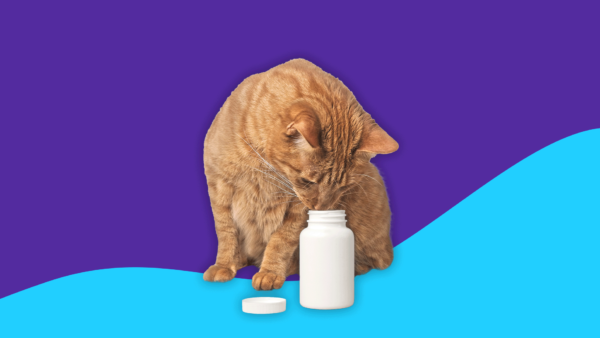
Can cats use metronidazole?

Can cats have Benadryl?

Zyrtec for dogs

Fun and safe ways to adventure with your cat
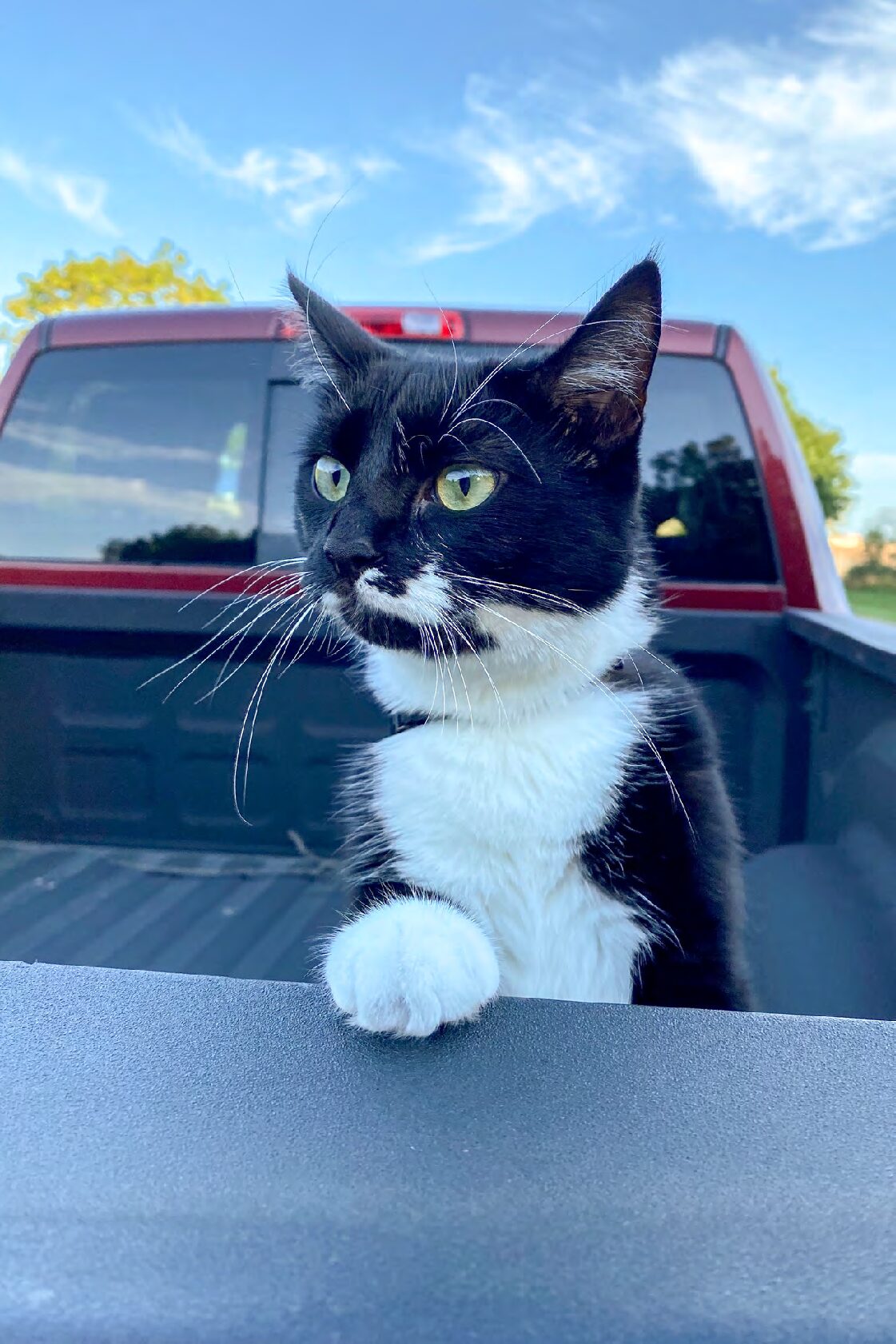
HOW TO DEAL WITH MOTION SICKNESS IN CATS
Having cats with motion sickness is understandably not ideal when needing to travel. Whether it be car rides, in their backpack, a bicycle, or even on a boat, motion sickness can strike at any time and it is not pleasant for your kitty. Motion sickness can occur in any cat, regardless of age, breed, or sex. However, it typically affect kittens and those who may not be used to traveling as much.
What is motion sickness?
There are two main causes of motion sickness in cats. The first one relates to balance. There is a balance system in the inner ear that communicates with their brain. If off balance, due to motion or pressure changes, it can activate their emetic center in their brain (making them vomit) or their GI tract (increasing their motility and causing your cat to need to go to the bathroom). Kittens are actually more prone to motion sickness, as their balance center in their ears are still immature. So, there is a chance that a kitten experiencing motion sickness could outgrow it.
The other common cause of motion sickness is fear, stress, and anxiety. If your cat gets very stressed and scared of the car, boat, bicycle, etc., they can get themselves so worked up that they become nauseous. We have a few tips to try to help your cat feel more comfortable, but these may not work for every cat and some cats may not be able to overcome their motion sickness.
Is motion sickness deadly?
Motion sickness itself is not a fatal condition to your cat, however it can cause added stress and anxiety or lead to problems that may be life threatening.
One problem with motion sickness is that some of the symptoms (the starred ones below) can lead to dehydration. Because of this, be sure that your cat drinks water when you are at your destination. Canned food or squeeze up cat treats are great too, as they have high moisture contents and can also serve as a reward to your cat when the trip is done. If the dehydration is severe, your cat may need to get fluids from a veterinarian to correct this.
- To check their hydration status, try the skin tent test. Pinch a bit of their skin around their shoulder blades and gently pull it up. When you let it go, it should snap right back to normal. If it returns to normal slowly, your cat is dehydrated. Be sure to offer water and high moisture canned food or treats. If skin stays tented up and does not fall back at all, your cat is severely dehydrated and should be taken to a veterinarian immediately.
Another issue with motion sickness is the vomiting. This can cause them to aspirate, meaning that they breathe in the vomit and it goes to their lungs. This can cause serious infection (aspiration pneumonia), which can make your cat very sick. It also can be life threatening and require intensive care.
Symptoms of motion sickness include, but are not limited to:
- Excessive drooling/salivation*
- Excessive vocalization
- Restless and inability to get comfortable
- Frequent or unexpected urination and/or bowel movements*
Tips to prevent motion sickness
- The younger they are, the easier it will be for them to adjust and get used to it. However, older cats can still love traveling and not get sick!
- Bring your cat for a drive around the block every day or every couple of days so that they get used to quick rides.
- You want to make sure that the vet is not always the end result of a car ride. Your cat can begin to associate the car with a negative experience then.
- This will help tire your cat out, so they may just curl up and sleep for the duration of the trip.
- Bring your cats favorite blanket or toy for them to lay on so that they feel at home and may help calm them down.
- Keep it at a good temperature for your cat. If they get too hot, they can get uncomfortable too.
- It is best to also keep the windows rolled up to help limit the amount of noise in the car.
- Some soft, quiet music may help as well. Do not keep the radio volume up too high, as again, too much noise can stress out your cat.
- Bring a backpack along for them to retreat to if they get scared. It can act as their safe place and offer comfort to them. We have an article on how to get your cat to love their backpack if you are interested in using one as a safe spot for them!
- Provide shade if you will be out in the sun to help prevent your cat from overheating. You can bring along an umbrella or portable fan to help keep them cool.
- Some cats may not get sick unless they have a full stomach. If you know your cat gets sick when traveling if they ate just before, try taking away their food and water about 1-2 hours before you are leaving.
- There are many calming sprays, wipes, and diffusers available to that mimic the pheromones cats release from their glands when they are calm. Pheromones are natural chemicals cats produce and use as a form of communication with other cats.
- One of the biggest names in this field is Feliway. Their spray is very popular, which you can check out on Amazon here , but also have diffusers.
- Another great option is from Travfurler. They offer a spray and wipe bundle kit that you can check out here .
- For plane or boat rides, this may not be possible. But if you are going on a long trip in the car, be sure to take frequent breaks to let your cat out of their carrier and give them a rest from the moving vehicle.
- Some cats may need the strength of veterinary prescribed medications to help combat motion sickness. You can call your veterinarian for an appointment and they can prescribe anti-nausea medication for your cat before a planned trip.
- Some cats are very vocal and restless in the beginning but will settle down after some time. Help them to feel comfortable and safe until they have gotten used to it and calm down.
- If they do vomit, drool, pant, etc., try some of the other tips to help them out and talk to your veterinarian about things to help alleviate their stress during travels.
- Some cats will never be able to overcome their motion sickness. If this is the case, you want to make sure they travel as little as possible. As much as you would like to bring them with you, it may be in your cat’s best interest to stay behind on some trips.
- You can also look into having a mobile vet come to your home for veterinary appointments, so your cat does not need to travel for that either.
How to combat motion sickness
First, figure out what is causing the motion sickness. Is there a common pattern you see of when they get sick? Is it stress and anxiety, is it from eating before hand, is it just on long rides, is it just certain activities (maybe car sick but fine on boats), or is it every time? Then, try some of our tips to help them out for their issue. Your veterinarian can be a great resource and may have some additional tips for you to try as well! We hope this article was helpful and that your cat starts getting used to and enjoying trips you have planned in the future! Good luck!
As always, please feel free to comment or email us if you have any questions and we will try to help in the best way we can.
Disclaimer: This post is not intended to serve as veterinary advice. We always recommend you call or visit a veterinarian if you have any concerns about your cat’s healt

MEET NUGGET

HOW TO DEAL WITH SEPARATION ANXIETY IN CATS
You may also like.
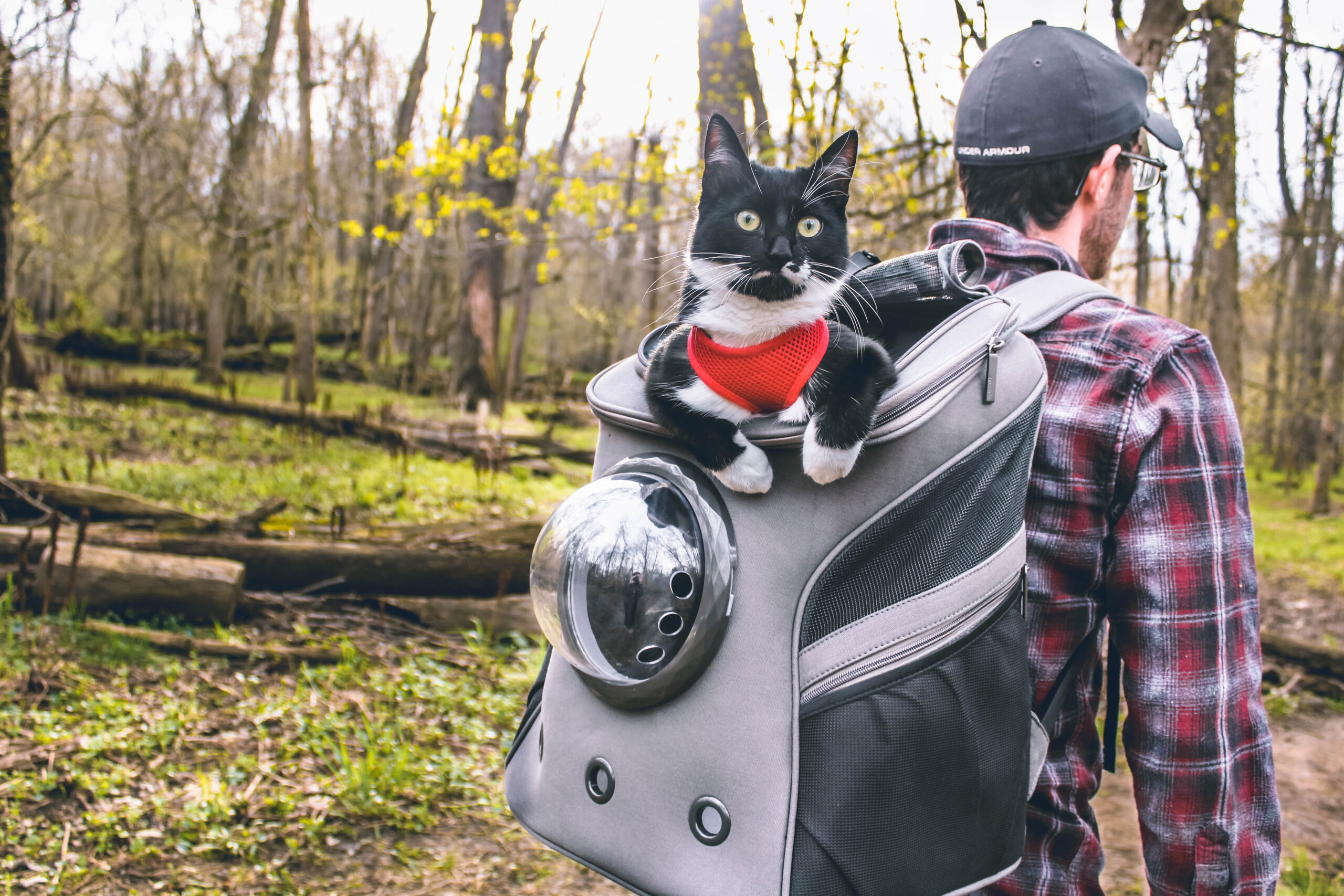
HOW TO FIND THE RIGHT BACKPACK FOR YOU AND YOUR CAT
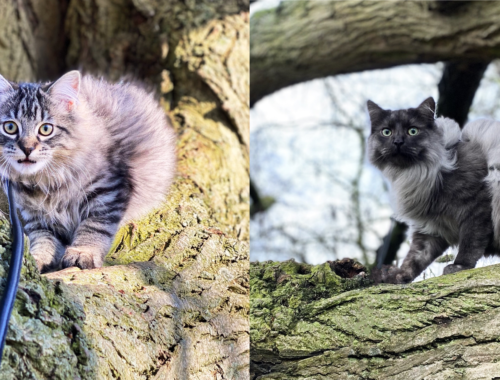
Meet Otje And Pluk
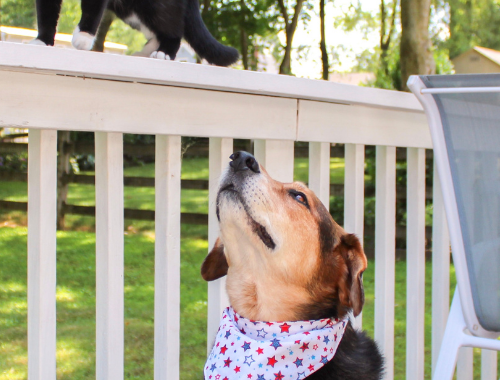
How To Prepare For The Fourth Of July With Cats

How to Prevent Motion Sickness in Cats
So you’ve traveled a few times with your cat. He may have shown signs of being sick or drowsy. You are probably wondering how to prevent motion sickness in cats? Whether you went to his yearly trip to the vet or just to go out for a quick hike, it’s always a good idea to be prepared. Believe it or not, motion sickness in cats is a real thing. First of all, what is motion sickness?
Motion sickness in cats is similar to when humans get motion sickness. Have you ever tried to read a book while a car is in motion? To lots of people it can cause you to get dizzy or have “motion sickness” Continue on and I will teach you how to be prepared in case your little feline friend decides to get motion sickness while you are traveling.
Table of Contents
What Causes Motion Sickness In Cats?
Motion sickness can happen in more than one place. Motion sickness is most common on boats and in cars. It occurs when the constant movement of a vehicle disrupts a cat’s sense of balance. Motion sickness affects all cats regardless of age, size, and breed. It is also more likely to affect a kitten than an adult cat because they are still developing. Although a kitten is more likely to get motion sickness, I believe it is best to start them young. The quicker your cat acclimates to car rides, the better it will be in the future when you start traveling a lot more.
Not only does the constant bumps and vibration cause motion sickness, it is also possible that your car’s engine noise can disrupt and cause stress to your cat. Motion sickness from a car ride is not fatal, but it can cause fear and subsequent rides in a car will be much harder for your cat. Motion sickness in cats can also cause dehydration and anxiety .
What are the Signs and Symptoms of Motion Sickness?
The first thing to do is examine your cat. He may look lethargic and may not eat a snack when he is given one. Your cat will start to be very vocal during the trip when they start to experience motion sickness and they may also start to excessively drool. During prolonged periods of motion sickness, your cat may also begin to pant. This is usually a sign that your cat is dehydrated because cat’s do not sweat the same way us humans do.
Another sign of motion sickness in your cat is restlessness. Restlessness comes in a few forms. Your cat will start to be more vocal and will constantly be moving around or “restless”. Your cat may also experience vomiting. Motion sickness makes your cat dizzy and causes nausea. This leads can lead to dehydration which can be fatal if it is not addressed accordingly. Your cat may also start to urinate or have bowel movements more frequently. You will easily be able to tell this is happening by the smell of your car.
Don’t worry, the more your cat rides in the car with you, the less likely he will become car sick. It’s better to start traveling with your cat when they are young so once you start your adventures, he will also be accustomed to riding in a car.
Can I Give My Cat Motion Sickness Medicine?

Yes. You can actually give your cat medicine to treat motion sickness before going on a trip. You can use an over the counter medicine like dramamine from amazon. A safe dose to give your cat is 12.5 mg. These tablets are dosed at 50 mg per tab, and have a score down the middle for easy cutting. Once you cut the pill in half you will then need to cut it in half once more to create a quarter pill which is 12.5 mg.
Be careful not to overdose your cat on this medication because the side effects can be potentially fatal depending on the dose. I would also advise speaking to your cat’s vet before giving them any form of over the counter medication. Some cats will respond fine while other cats may have a negative reaction.
How to Prevent Motion Sickness In Cats Naturally
You may just have bad luck and your cat is more prone to car sickness than another cat. All cats are different in this aspect. Some will handle cars without getting sick at all, while others will get sick almost every time until they get used to it. The single best way to help your cat through motion sickness is to get them used to traveling inside their carrier. Take them with you whenever you leave the house to expose them to as much drive time as possible.
This may seem counter productive at first, but after awhile you will slowly start to notice subtle changes in the way your cat behaves during the car rides. He will start to act more “normal”. Start getting your cat used to his carrier by slowly introducing it to him at home. Leave the carrier door open and leave cat treats inside. Always reward his behavior whenever he goes inside his cat carrier. Encourage him to play near it as well as sleep in it at night time.
Once you feel that your cat is used to his carrier, you can start placing him inside the car while he is in his carrier. Remember, always use positive reinforcement with him and the carrier. This is very important to calming him down once he is inside the carrier and car. The next step is to start the engine and do small drives around the block to get your cat used to the feel of the car.
This is not the time to take him on a 100 mile road trip. Start small and gradually increase the distance traveled every few days or so. This will also give you a good idea on how your cat behaves while you are driving. It’s easier to handle the situation when you are just doing test drives. How awful would it be if your cat started panting, vomiting, and shaking while you were on your way to a trail for a hike ?
Car Comfort Tips for Your Cat
- There are a variety of things you can do to help keep your cat comfortable during a car ride.
- Make sure you plan your trip ahead of time and make sure he hasn’t just eaten. A cat with a full belly is more likely to get motion sickness than a cat with an empty stomach. If you must feed your cat, wait a few hours before you start your travel.
- Be sure to place your cat in the correct position. Do not face him backwards or sideways. Always keep him facing forward toward the front to help with his orientation. Keeping his orientation correct will help prevent motion sickness.
- Have you ever felt stuffy while riding in a car? Well so does your cat. Go ahead and crank the ac on to give him a breath of fresh air. Circulating the air in your car will help him from getting sick as well.
- I already said that the noise from your cars engine can cause anxiety in your cat . For your first few trips try to refrain from playing loud music. This will just be another form of stress added to your already stressed out cat.
- If you notice your cat starting to show signs and symptoms of motion sickness, go ahead and take a quick break. Stop your car and go for a small walk to calm him down and relieve his motion sickness. The short stroll and fresh air will work wonders for him.
Preventing Motion Sickness On A Boat

Motion sickness is very common when on a boat. Being on a swaying boat usually gets to the best of us as well. I remember the first time I went whale watching at the pier. About halfway through the trip I just started to feel really dizzy. After the dizziness then cam the nausea. I didn’t actually end up throwing up during my whale watching trip, but it definitely made my trip less enjoyable. Well the same thing can happen to your cat while on a boat as well. Boating with your cat can be a good time, but you will need to know how to keep him safe from motion sickness. Your cat’s chances of catching motion sickness on a boat is very high.
The main thing you can do for your cat is to keep him away from the middle and top of the deck while the boat is in motion. The higher up your cat is on the boat means the more of the waves that he is going to feel. It is best to keep your cat below deck levels in order to prevent motion sickness from creeping up on him. The waves and shaking are felt substantially less on the bottom floors. This is also a good tip for humans that tend to get motion sickness on boats as well.
Another thing to do to help prevent motion sickness in your cat is to put him in his cat carrier on a cooling pad while the boat is in motion. Keeping your cat on the bottom deck in a carrier will help minimize your cat’s movement. Adding a cooling pad like this one from amazon will also help in relieving anxiety and nausea that may be building up from the boat rocking.
What Do I Do If My Cat Starts Vomiting?
There is nothing much you can do about the vomiting part. You will have to wait until your cat stops vomiting before aiding him. Once his vomiting has subsided he may be dehydrated. This is a good time to slowly introduce water. The keyword here is slowly. Giving him too much water at once can cause his electrolyte imbalance to worsen. If your cat will not drink water (this may be the case) because he is not feeling well then you can try to provide him with some wet cat food. Wet cat food has a small amount of water and may help in replenishing lost fluids. It may not be much, but at least it’s something. Avoiding giving your cat any treats or dry food at this point until you are sure he is starting to feel better.
Does My Cat Need To See The Vet If He Gets Motion Sickness?
For the most part no. Your cat does not need to go to the vet if he has had an episode of motion sickness. Motion sickness is not a disease or an illness. Motion sickness is more commonly referred to as a temporary condition. Once your cat escapes the source that is causing the motion sickness then he should be fine. The only time you will need to take your cat to the vet due to motion sickness is if he gets severe dehydration. Severe dehydration can happen if your cat decides to not drink or eat for a few days after vomiting from motion sickness. Your cat will act lethargic, tired, and will most likely not be himself when he is dehydrated.
Final Thoughts
I’m sure you have experienced motion sickness at least one time in your life whether on a boat or in a car. The reality is it sucks. I remember getting motion sickness the first time I went whale watching. I couldn’t enjoy the trip at all because I was too busy trying not to vomit. In essence, motion sickness in cats works the same way. They will learn to hate going in the car and that is the last thing you want for you feline friend. Start slow and take the needed steps to acclimate him to car rides. I’m sure if you take everything I have mentioned and put it to use, traveling with your cat won’t be as difficult as you thought.
Related Posts
Can a spayed cat produce milk, tuna water for cats: is it healthy [pros & cons], can cats suffocate under blankets, leave a comment:.
Save my name, email, and website in this browser for the next time I comment.
Should You Sedate A Cat For Travel?

If you have to travel with your cat, it’s not always easy. Whether it’s a short trip to the veterinary clinic or cattery, or a longer trip for a vacation, you don’t want your cat to feel distressed. Of course, in an ideal world, you would avoid traveling with your cat if it affects them (and you) badly, but certain trips are unavoidable.
Key Takeaways
Many cats dislike care travel due to the random movement, loud noises, and motion sickness.
You can make car travel less stressful for your cat by using pheromones or calming sprays , choosing an appropriate carrier, and reducing loud noises in the car.
Speak to your veterinarian about light sedatives, calming medications, and anti-nausea medications for cats that get very stressed in the car.
Let’s find out why cats struggle with traveling and what options you have if you want to help make it easier for them.
Why Might Cats Struggle With Traveling?
As humans, we might find traveling boring, or uncomfortable, or if we suffer from motion sickness it might make us nauseous. These issues can affect cats as well, but they also have other aversions to travel.
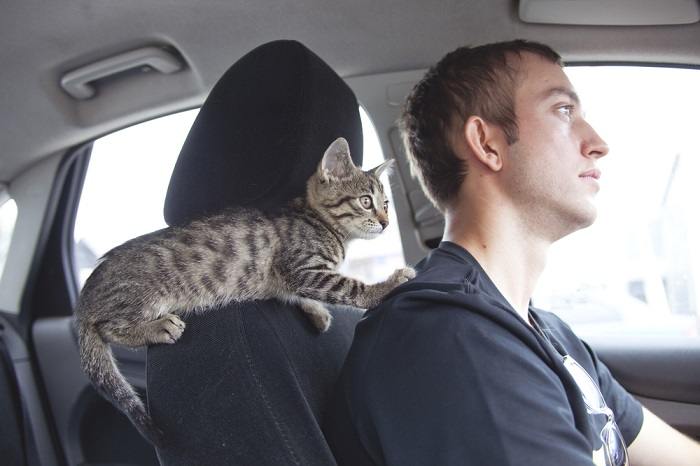
Most cats don’t travel by car very often, so they can find it anxiety provoking.
Cats don’t like anything out of the ordinary. They’re creatures of habit and enjoy the familiar. So. If they find themselves in a setting like a car, with unfamiliar sights, sounds, and smells, it can make them very anxious. If your cat gets stressed in the car, you might notice them vocalizing loudly , trying to break free from the cat carrier, or even open-mouth breathing .
Over time, stressful events can lead to health problems, including cystitis and other urinary issues as well as overgrooming , so if your cat has been subjected to stress, it’s important to keep an eye out for any signs that something is amiss.
Also Read: The Best Cat Carriers

Some cats suffer from motion sickness, which can make travel very unpleasant for them.
Just like humans, cats can experience travel sickness. This could be due to the motion of the vehicle but could also be exacerbated by warm temperatures and distress. Even if your cat doesn’t vomit during car journeys, they might still be feeling nauseous . Keep an eye out for telltale signs like drooling and vomiting .
Also Read: Best Large Cat Carriers For Travel Reviewed
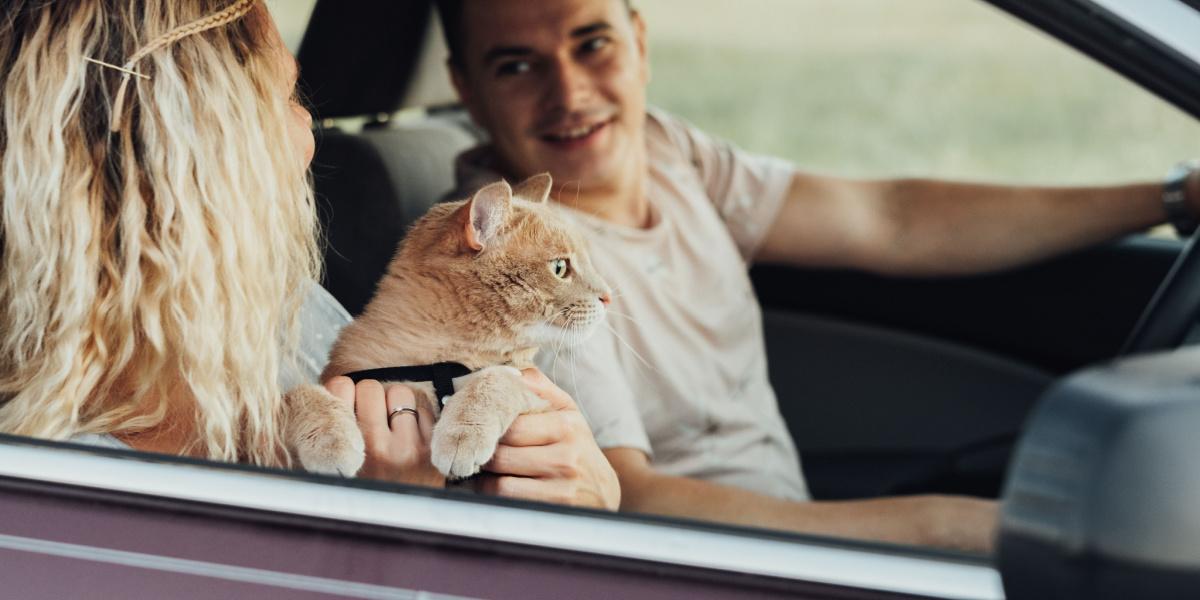
The sound of the car and other road sounds can bother a cat’s sensitive hearing.
Cats are very sensitive to noise and have excellent hearing . You’ve probably noticed their ears twitching in response to very small noises around the house. Much louder noises like the car engine, horns, or music from the stereo could leave your cat incredibly frightened.
Also Read: 7 Sounds Cats Hate That You Should Avoid
4. Movement

Many cats find the movement involved with car travel uncomfortable or stressful.
Cats like to be in control of their movements, and I’m sure we can relate. Cats feel safer when they are in control and able to choose where they go and what they do. When placed in a cat carrier in a car, they don’t understand what’s going on and the movements as the car swerves, starts, and stops can seem random and scary.
Also Read: 8 Ways To Help a Scared and Fearful Cat Be Confident
5. Restriction
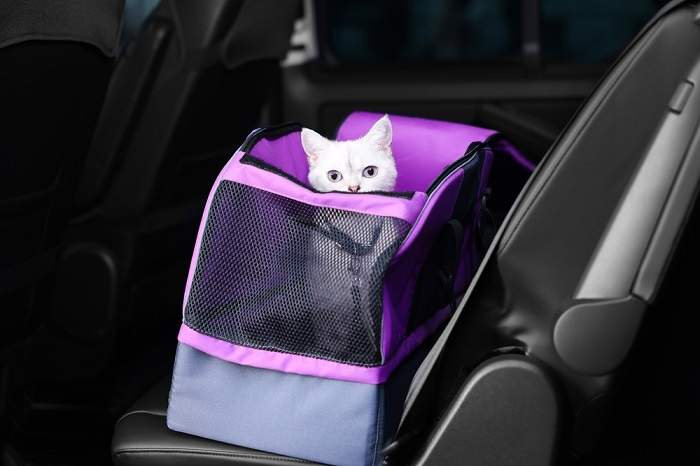
Although traveling in a carrier is safest, some cats don’t enjoy being confined.
Many cats like small spaces, but on their terms. So, you might find your cat chilling behind the sofa, in a tiny cardboard box , or in a drawer at the bottom of the wardrobe, but that doesn’t mean they’ll enjoy a trip in the cat carrier. When the element of choice is removed, being placed in a cat carrier and confined can make your cat feel powerless and anxious.
Also Read: Why Do Cats Sleep With Their Head Up?
How Can You Help Your Cat Cope Better With Travel?
With the best will in the world, it’s not always possible to keep your cat happy by avoiding travel altogether. Some trips are important, for instance, if you’re moving house, taking your cat for their annual veterinary checkup, or dropping them off at a boarding facility. So, what’s the solution for necessary trips? The good news is, you can help your cat feel better about traveling with a few proven tips.
1. Use Familiar Scents
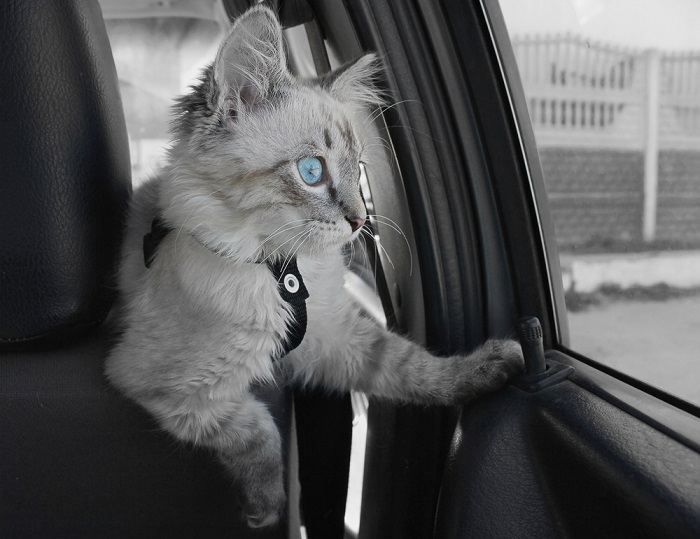
When traveling, bringing some scents of home can help your cat feel calmer.
Part of making your cat feel at ease is creating a more familiar environment to help them feel more secure and confident. A t-shirt or other item of clothing that smells of you, or a cozy blanket from their bed will help fill their senses with thoughts of home.
Also Read: What Are Cat Pheromones And Do They Really Work?
2. Choose The Right Carrier Or Other Restraint

Cats can all have different preferences, so if your cat doesn’t seem to like their carrier, try something different.
There are lots of different types of cat carriers out there, so it’s worth trying to find one that suits your cat best. Some might prefer plenty of space, while others might prefer to feel enclosed in a smaller space.
Some might like to be able to see out, so a see-through plastic option might fit the bill, but others might prefer a dark space, covered by a blanket or towel. If you’re traveling on an airplane rather than a car, make sure you check the dimensions and type of carrier that is accepted by the airline.
For short journeys, you might choose to secure your cat in the car via a secure leash or harness , rather than using a carrier.
Also Read: How To Get A Cat Into A Carrier: 6 Steps For Success
3. Use Calming Sprays
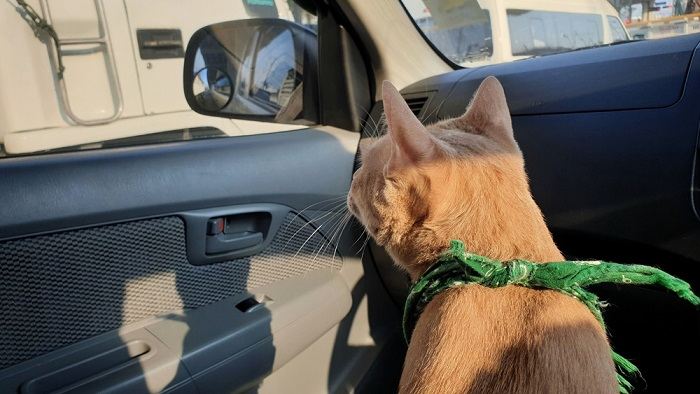
Cat pheromones and other calming products can help cats feel calmer in stressful situations.
Cat pheromones or calming sprays that contain valerian or other calming compounds can help to make your cat feel more relaxed. Feliway or Pet Remedy are just two examples of this. Try spraying a blanket or towel before placing it in your cat’s carrier. To get an even better calming effect, spray the area of the car where their carrier will be.
Also Read: Best Calming Aid For Cats
4. Reduce Noise

Turn the radio off in the car, or tune it to soothing music set to a low volume.
Blaring music from your car radio probably won’t help your cat feel calm. However, you could try playing classical or familiar music on a low volume to drown out the sound of the car engine and other traffic noise. Try to avoid engaging with and talking to your cat too much, as tempting as it is to comfort them. By giving them too much attention you can reinforce that there is something to be afraid of.
5. Desensitize Them
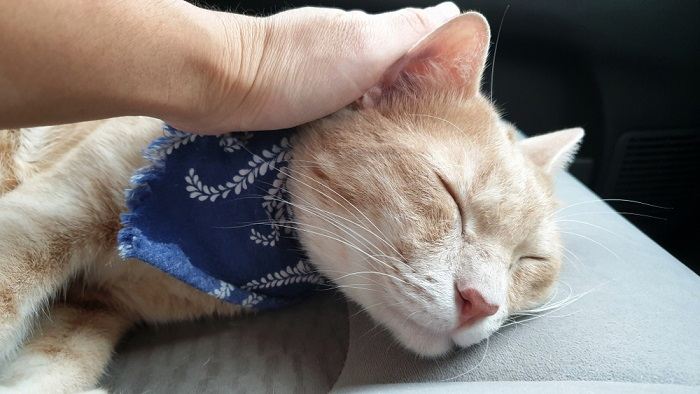
Cats can form negative associations with the car if you only ever go to the vet for unpleasant procedures.
If traveling is unavoidable, but it’s once in a blue moon, it might be worth trying to desensitize your cat. If they only go in the car to the vet, they’ll have a negative association with it. Try to take them on very short journeys regularly and reward them with treats and praise afterward to create a more positive experience that doesn’t affect them so much.
Also Read: The 7 Best Calming Cat Treats
6. Consider Sedation
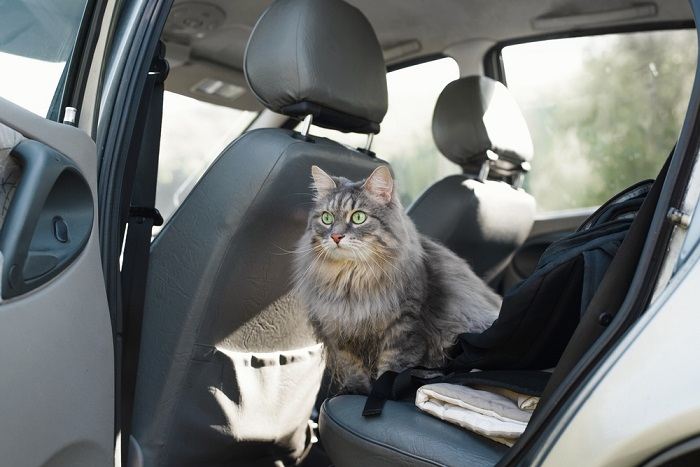
If your cat gets really distressed when they travel in the car, speak to your veterinarian about medication options like cat sedatives . Various veterinary medicines area available, from calming tablets to light and strong sedatives, including gabapentin , diphenhydramine (Benadryl) , benzodiazepines, chlorpheniramine, and trazodone .
Stronger sedatives or a higher dosage of sedation that your veterinarian might use in the clinic are not suitable for travel because a sedated pet needs to be closely monitored and be with a suitably qualified person in case any intervention is required.
The veterinary medicine that your vet chooses will depend on whether your cat will take a tablet or would prefer a liquid form of medication, and will take into account your cat’s age and health.
Also Read: Drug Poisoning In Cats: Causes, Symptoms, & Treatment
Risks Associated With Sedating Cats For Travel
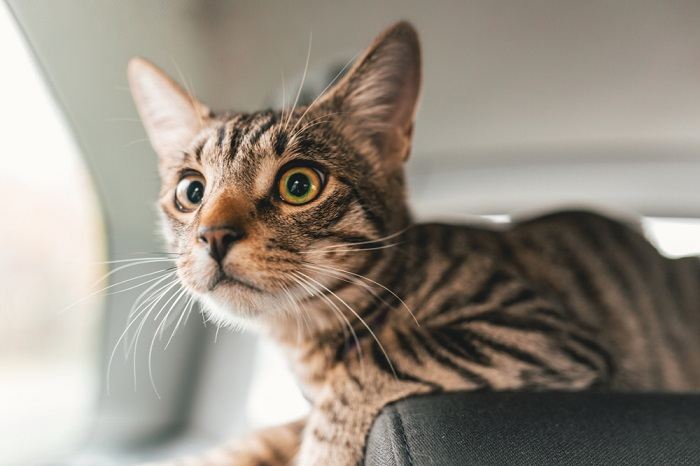
Even light sedatives carry some risks for your cat, even if you give the correct dose. First, if they have an underlying health problem like a heart condition, or liver or kidney disease, any medication could cause them to become unwell or even die.
That is why it’s particularly important to make sure your cat is checked over by a veterinarian and prescribed a sedative medication, rather than giving medication without veterinary advice.
Sedatives can also lead to side effects like vomiting , diarrhea , aggression , dry mouth, and lethargy and there is also a risk of anaphylaxis if your cat has allergies . These risks are some of the reasons why sedatives are not available over the counter and are only available on prescription.
Another worry is if your cat is sedated during a fearful event, certain medications might allow them to still be aware and afraid but unable to move or respond. This can create an even more negative experience and might make it even harder to travel with your cat in the future.
Final Thoughts
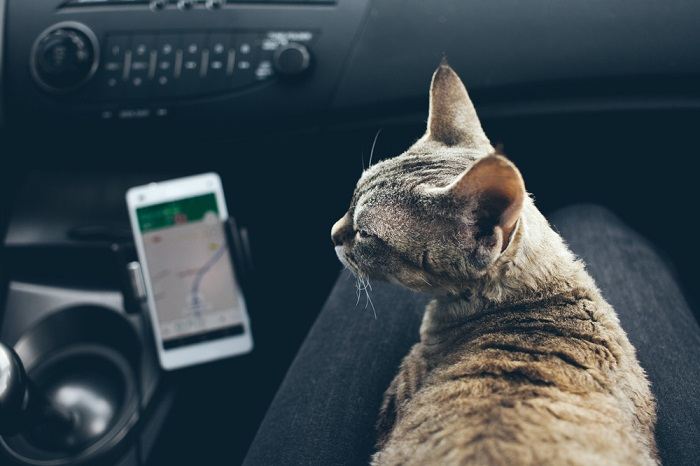
It’s upsetting hard if your cat becomes distressed during travel. However, it’s important not to give them any medication without speaking to a veterinarian first. It’s not safe to over-sedate your cat for a car journey because if anything went wrong a veterinarian or veterinary technician would need to administer additional medications.
Light sedatives, calming medications , and anti-nausea medications can be useful for cats that get very stressed in the car, so speak to your veterinarian about your options.
Also Read: The 5 Best Catnip Products For Cats (Spray & Toys and More Surprises)
Frequently Asked Questions
How do you calm a cat on a long car ride.
It's tempting to try to comfort your cat by talking to them on a long journey. However, unless you can talk to them normally, in a calm manner, it’s best to avoid speaking too much. If you act like you are trying to reassure them, you’ll be sending a message to them that there is something to be afraid of.
How do you drug cats on a road trip?
Never give your cat any drug for travel that hasn’t been prescribed by a veterinarian for that purpose. If you think your cat would benefit from medication during travel, ask your vet about the options available.
Why do cats freak out in cars?
Traveling in the car means random movement, loud noises, and generally feeling out of control. So, it’s not surprising that your cat might not enjoy a ride in the car. By adding familiar things and creating a safe and reassuring environment, you might find they feel a bit better.
More From Cat Safety Advice

Popular in the community

One thought on “ “Should You Sedate A Cat For Travel?” ”
Leave a reply cancel reply.
Your email address will not be published. Required fields are marked *
I drive around the country on the regular with 3-4 cats for show. They are used to it now. My old guy likes to travel.
The Ultimate Guide to Traveling with Cats: Should You Sedate Your Feline Companion?
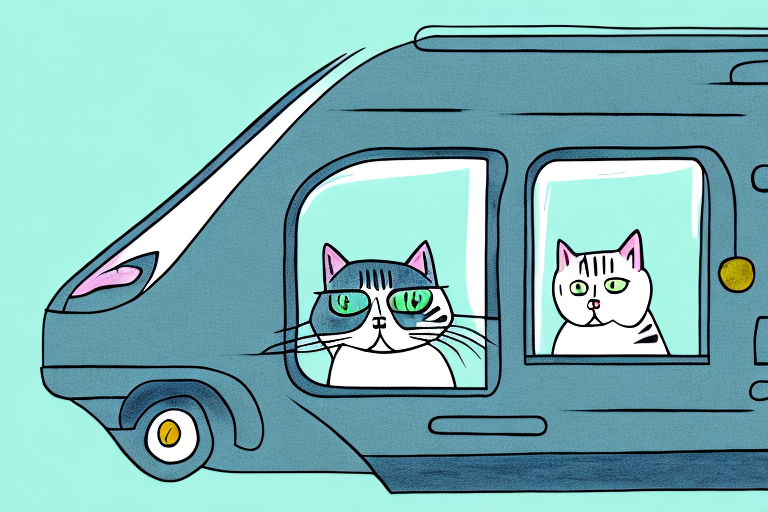
Traveling with cats can be a daunting task, especially if your feline companion experiences anxiety or motion sickness. As a responsible pet owner, it’s important to prioritize your cat’s comfort and well-being during travel. In this ultimate guide, we’ll explore the challenges cats face when traveling and provide practical tips to ease their anxiety. We’ll also discuss the use of sedation for cats during travel and the key considerations to keep in mind. So, whether you’re planning a road trip or a flight with your furry friend, read on to ensure a stress-free and safe journey for both of you.
A Quick Guide to Traveling with Cats
Understanding the challenges cats face during travel.
Traveling can be disorienting for cats, as it takes them out of their familiar environment. The sights, sounds, and unfamiliar surroundings can cause stress and anxiety. Cats are creatures of habit, and any disruption to their routine can be overwhelming. It’s important to understand the challenges cats face during travel to ensure their well-being and comfort.
One of the main challenges cats face during travel is the unfamiliarity of their surroundings. Cats are territorial animals, and being in a new environment can trigger feelings of insecurity and anxiety. The unfamiliar smells, sights, and sounds can be overwhelming, leading to stress and discomfort for your feline friend.
Another challenge cats face during travel is the fear of confinement. Cats are known for their independent nature, and being confined to a carrier or restraint can make them feel restricted and anxious. It’s crucial to choose a carrier that provides enough space for your cat to move around comfortably and feel secure.
Common Reasons for Cats’ Travel Anxiety
Cats may experience travel anxiety due to various reasons, including fear of confinement, unfamiliar noises, or separation from their home territory. It’s important to identify the specific triggers that cause anxiety in your cat to develop appropriate strategies to address them.
One common reason for travel anxiety in cats is the fear of confinement. Cats are naturally curious and like to explore their surroundings. Being confined to a carrier restricts their movement and can make them feel trapped. To help alleviate this anxiety, it’s essential to introduce your cat to the carrier gradually and make it a positive and comfortable space for them.
Another reason for travel anxiety in cats is the unfamiliar noises they encounter during the journey. From the engine sounds of a car to the hustle and bustle of an airport, excessive noise can heighten their anxiety levels. Providing a quiet and soothing environment can help reduce their stress and make the journey more comfortable for them.
Addressing Cats’ Travel-Related Nausea
Cats, like humans, can experience motion sickness during travel. Nausea can further contribute to their anxiety and discomfort. It’s essential to take steps to minimize travel-related nausea in cats and help them feel better during the journey.
One way to address travel-related nausea in cats is by feeding them a light meal a few hours before the journey. Avoid feeding them a large meal right before travel, as it can increase the chances of nausea. Additionally, you can consult your veterinarian about anti-nausea medications that can help alleviate your cat’s discomfort during travel.
Creating a comfortable and well-ventilated space for your cat in the carrier can also help reduce travel-related nausea. Ensure that the carrier is lined with absorbent bedding and has proper ventilation to prevent any buildup of odors that can trigger nausea.
Minimizing Noise-Related Stress for Cats During Travel
Noise can be a significant source of stress for cats during travel. From engine sounds to the hustle and bustle of unfamiliar surroundings, excessive noise can heighten their anxiety levels. Discovering methods to create a quiet and soothing environment for your cat during travel can make a world of difference.
One way to minimize noise-related stress for cats during travel is by using a carrier with sound-absorbing materials. These carriers are designed to reduce external noise and create a calm environment for your cat. Additionally, you can play soft, soothing music or use white noise machines to mask any loud noises that may cause anxiety for your feline friend.
It’s also important to choose a travel route that minimizes exposure to loud and chaotic environments. If possible, opt for quieter roads or choose flights during less busy times to reduce the overall noise levels your cat will encounter during travel.
Helping Cats Cope with Movement During Travel
The movement associated with travel, whether in a car or an airplane, can be unsettling for cats. We’ll explore ways to help your feline friend cope with movement and reduce their discomfort during the journey.
One way to help cats cope with movement during travel is by gradually acclimating them to it. Start by taking short car rides or practicing putting them in the carrier and gently moving it around the house. This will help them get used to the sensation of movement and reduce their anxiety during actual travel.
Using a carrier that provides stability and minimizes movement can also help reduce your cat’s discomfort. Look for carriers with secure fastenings and padded interiors to keep your cat steady and comfortable during the journey.
Strategies to Reduce Cats’ Feeling of Restriction During Travel
Being confined to a carrier or restraint can make cats feel restricted and anxious during travel. To ensure their well-being, it’s essential to implement strategies that minimize their feeling of restriction and provide them with a sense of security.
One strategy to reduce cats’ feeling of restriction during travel is by providing them with familiar items from home. Place a blanket or bedding with their scent in the carrier to create a sense of familiarity and comfort. Additionally, you can include their favorite toys or treats to help distract and calm them during the journey.
Another strategy is to allow your cat some freedom of movement during travel. If it’s safe to do so, consider using a harness and leash to give your cat supervised access to the car or airplane cabin. This can help alleviate their anxiety and make them feel less confined.
Remember, every cat is unique, and what works for one may not work for another. It’s important to observe your cat’s behavior and make adjustments accordingly to ensure their comfort and well-being during travel.
Tips for Easing Your Cat’s Travel Anxiety
Traveling with cats can be a stressful experience for both you and your feline friend. Cats are known for their sensitivity to changes in their environment, and being in a moving vehicle can trigger anxiety and fear. However, with the right strategies and tools, you can help ease your cat’s travel anxiety and make the journey more comfortable for them.
In this article, we will discuss various tips and techniques to help your cat feel more secure and relaxed during travel. From utilizing familiar scents to choosing the right carrier or restraint system, we will explore different ways to create a calm and soothing environment for your cat. Let’s dive in!
Using Familiar Scents to Comfort Your Cat During Travel
Scent plays a crucial role in calming cats. By introducing familiar scents during travel, you can help your cat feel more secure and reduce their anxiety levels. One effective way to utilize scent is by placing a blanket or towel in your cat’s carrier that carries their scent from home. The familiar smell will provide a sense of comfort and familiarity, making the journey less stressful for your cat.
Additionally, you can also consider using pheromone sprays specifically designed to calm cats. These sprays mimic the natural pheromones that cats release when they feel safe and relaxed. Simply spraying the carrier or the surrounding area with this calming spray can help create a soothing atmosphere for your cat during the travel.
Choosing the Right Carrier or Restraint for Your Cat
The choice of carrier or restraint can greatly impact your cat’s comfort during travel. It is essential to select a carrier that is spacious enough for your cat to move around comfortably but also secure enough to prevent any escapes. A carrier with a solid base and good ventilation is ideal for ensuring your cat’s safety and well-being.
Another important factor to consider is the type of restraint system you use in the car. There are various options available, including seatbelt harnesses and travel crates. The key is to choose a restraint system that keeps your cat secure and prevents any sudden movements that can cause anxiety. It is recommended to introduce your cat to the carrier or restraint system well in advance of the travel to allow them to familiarize themselves with it.
Calming Sprays: A Tool to Soothe Your Cat During Travel
Calming sprays can provide an extra layer of relaxation and comfort for your cat during travel. These sprays typically contain natural ingredients such as lavender or chamomile, known for their calming properties. When sprayed in the car or the carrier, these sprays can help create a serene atmosphere that promotes relaxation for your feline friend.
Before using any calming spray, it is essential to read the instructions carefully and consult with your veterinarian if your cat has any specific health conditions or sensitivities. It’s also worth noting that while calming sprays can be beneficial for many cats, they may not work for all. Each cat is unique, so it’s important to observe your cat’s response and adjust accordingly.
Creating a Quiet Environment for Your Cat During Travel
A peaceful and quiet environment can significantly reduce your cat’s stress levels during travel. To create a tranquil setting, you can minimize external noises by playing soft music or using noise-canceling devices in the car. It’s also helpful to avoid sudden loud sounds or abrupt movements that can startle your cat.
Furthermore, you can cover the carrier with a lightweight blanket or towel to create a cozy and enclosed space for your cat. This can help block out excessive light and provide a sense of security. However, ensure that there is still proper ventilation to keep your cat comfortable.
Desensitization Techniques for Cats’ Travel Anxiety
Desensitization techniques can help your cat become more accustomed to travel and alleviate their anxiety over time. The goal is to gradually expose your cat to travel-related stimuli, such as the carrier or car, in a positive and controlled manner.
Start by introducing the carrier as a safe and familiar space in your home. Leave it open with comfortable bedding and treats inside, allowing your cat to explore and associate positive experiences with it. Once your cat feels comfortable entering and staying in the carrier, you can slowly introduce short car rides, starting with just a few minutes and gradually increasing the duration.
During the car rides, provide your cat with treats and praise to reinforce positive associations. It’s essential to monitor your cat’s behavior and adjust the pace accordingly. Remember, patience and consistency are key when desensitizing your cat to travel.
Understanding the Risks of Sedating Cats for Travel
Sedation is sometimes considered as an option to calm cats during travel. However, it’s important to understand the associated risks and consult with a veterinarian before considering sedation for your cat.
While sedation may seem like a quick solution, it can have potential side effects and may not be suitable for all cats. The sedative medications can affect your cat’s balance, coordination, and overall well-being. Additionally, some cats may have adverse reactions or allergies to certain sedatives.
If you are considering sedation, it is crucial to consult with a veterinarian who can assess your cat’s health, behavior, and specific travel needs. They will be able to provide professional advice and recommend the safest options for your cat.
By implementing these tips and techniques, you can help ease your cat’s travel anxiety and ensure a more comfortable journey for both you and your feline companion. Remember, every cat is unique, so it’s important to be patient, observe your cat’s behavior, and tailor your approach accordingly. Safe travels!
Key Considerations for Sedating Cats During Travel
When it comes to sedating cats for travel, there are several key considerations to keep in mind:
- Consult a veterinarian: Always seek professional advice before considering sedation for your cat.
- Choose appropriate sedative: The choice of sedative should be tailored to your cat’s specific needs and health condition.
- Follow dosage instructions: Administer the sedative according to the veterinarian’s instructions to ensure the safety of your cat.
- Monitor your cat closely: Keep a close eye on your cat during travel to ensure they are not experiencing any adverse reactions to the sedative.
- Consider alternative options: Explore alternatives, such as non-medicated calming techniques, before resorting to sedation.
Final Thoughts on Traveling with Cats
Traveling with cats can be a challenging but rewarding experience. By understanding the specific challenges they face and implementing appropriate strategies to address their anxiety, you can create a more enjoyable journey for both you and your feline companion. Remember to prioritize your cat’s well-being and consult with a veterinarian for personalized advice. Happy travels with your furry friend!
Frequently Asked Questions about Traveling with Cats
Tips for calming a cat on a long car ride.
Long car rides can be stressful for cats. Here are some tips to calm your cat during a lengthy journey:
- Provide a comfortable carrier with familiar bedding and toys.
- Create a quiet and peaceful atmosphere in the car.
- Play soothing music to help your cat relax.
- Take frequent breaks to allow your cat to stretch and use the litter box.
- Consider using calming sprays or supplements recommended by your veterinarian.
By following these tips, you can help your cat feel more at ease during long car rides and ensure a smoother travel experience.
Watch CBS News
Flying with pets? Here's what to know.
By Anne Marie Lee
Edited By Alain Sherter
Updated on: April 6, 2024 / 10:08 AM EDT / CBS News
Thinking of taking your dog or cat with you the next time you fly? For a growing percentage of the 90.5 million pet owners in the U.S., the answer is yes. But while the notion of boarding a plane with your pet may seem simple, the rules and restrictions around traveling with an animal can be confusing.
Eight major U.S. airlines allow pets to fly in-cabin as carry-ons. But flying with your pet takes research and planning, as pet policies vary from airline to airline, are steeped in restrictions, and are limited to specific countries and cities. You'll also have to pay an extra fee for your pet ranging from $95 to $200, depending on the airline and where you're flying. And restrictions often change.
For example, American Airlines recently revised its policies so passengers flying with pets may also bring one full-size carry-on or personal item. But the carrier prohibits carry-on pets on transatlantic and transpacific flights. Here's what you need to know when considering taking your fur baby with you on a plane.
Cargo, check-in or carry-on?
Most airlines offer three options for transporting animals: cargo, check-in or carry-on. But if your pet is larger than a bread box, your options are limited to the cargo or baggage check-in options, with very few exceptions.
Given that large canine breeds such as Labrador Retrievers, German Shepherds and Golden Retrievers are among the most popular dogs in the country, the size restriction for in-cabin pet travel can be a major frustration for those who would rather not fly at all if that means putting their pet in cargo.
A 2023 Forbes Adviser survey of 10,000 U.S. dog owners found that 33% of respondents fly with their pets, while 37% listed not being able to bring their dog on a plane as their biggest annoyance. (You can learn more about the differences between cargo, check-in and carry-on options here , including warnings about the dangers involved when pets travel in the cargo hold.)
Carry-on pets
Even for pet owners whose animals are small enough to fly as a carry-on, traveling is no breeze.
"When I fly with him I have to go to the desk," Margaret Rauch, 44, told CBS MoneyWatch, referring to her 15-pound poodle mix, Soda. The New York City resident has taken Soda on dozens of flights to St. Croix in the U.S. Virgin Islands, where Soda, now 4, was being fostered by a friend after being found as a stray puppy in 2021.
In addition to calling the airline in advance to register her dog for a flight, Rauch has to check in at the counter whenever she's traveling with Soda, so the airline agent can confirm her dog and pet carrier conform to the in-cabin pet requirements and that the flight hasn't already met its pet maximum.
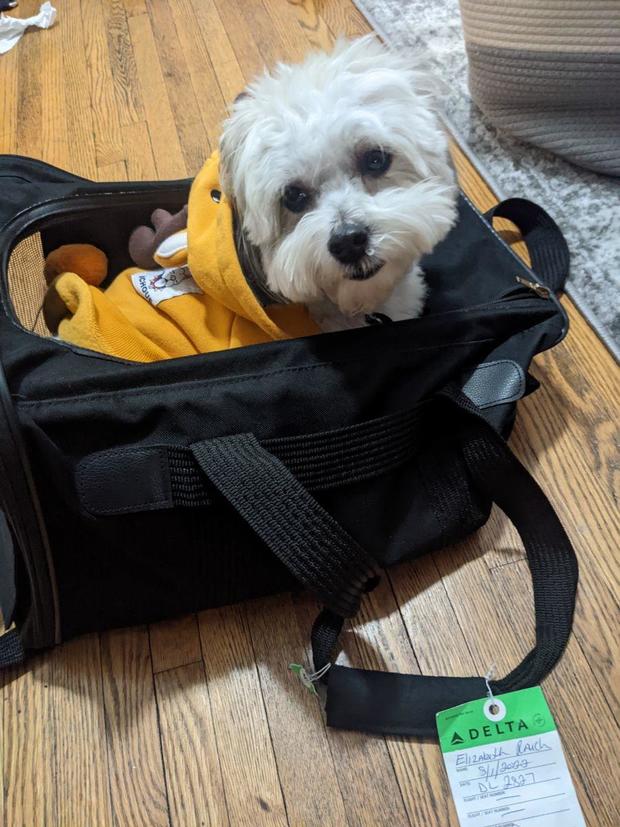
Rauch, who said she would never consider putting Soda in cargo, applauded American Airlines' new policy, while noting that in her experience the one carry-on rule was rarely enforced.
"I feel the price is already high for what I get. Even with AA's rule change, I lose the underseat space," she said. "My dog creates no extra work for anyone."
Despite the added preparation, paperwork and hassle involved in flying with Soda — not to mention the unfriendly looks she occasionally detects from fellow passengers at the sight of her pet carrier — Rauch said, "It's absolutely worth it."
Asked how the experience could be improved, she pointed to early boarding for pet owners as something that would help.
"If you can get in early, get a seat and settle down, that is an accommodation I don't expect to see anytime soon but I think it makes sense," Rauch said.
Safety and comfort
For the many Americans who see their pets practically as family members, one of the most challenging aspects of flying is ensuring their animal's comfort and safety.
"The increasing humanization of pets, which involves treating them as part of the family rather than as mere animals, has increased the demand for pet travel services that are of high quality and can be customized to meet the specific needs of each pet," LinkedIn reported in December.
Among other tips, the U.S. Department of Transportation and animal experts recommend that you not feed your pet four to six hours before a flight and limit their water intake. Others also suggest keeping bottled water on hand at all times. Additionally, most airlines require certain vaccination and vet certification that your pet is healthy enough to fly. Individual countries also have their own requirements for pets to enter.
Not surprisingly, some airlines do better than others at handling pets. One of the best-rated carriers for pet travel is Alaska Airlines, which has repeatedly topped rankings, such as NerdWallet's Most pet-friendly airlines of 2024. In recent years, the airline also has maintained one of the industry's lowest incident ratings, according to Veterinarians.org. United Airlines and Delta are among the airlines with the highest incident rates, according to the pet information website.
On Rauch's first plane trip with Soda traveling home to New York, a layover in Miami led to the flight sitting on the tarmac for two hours. Calming treats are something that helps keeps her dog relaxed on flights. She also withholds Soda's food and limits his water intake up to five hours before a flight, which is also helpful given that he doesn't like using pet relief areas, which she said generally smell of urine and can be overwhelming for dogs. Flights between New York City and St. Croix are generally under six hours.
"I'm not sure how I'd handle a flight to Singapore," Rauch said.
Here's a rundown of U.S. airlines' pet travel policies, along with fees and and restrictions:
Alaska Airlines
Pet fee: $100
Pets allowed: Dogs and cats are the only pets allowed in-cabin on international trips and flights to Hawaii. Domesticated rabbits and small household birds are allowed as carry-on on domestic flights.
Destinations: Domestic and international, with additional requirements and documentation required for pets traveling to Hawaii or internationally .
See Alaska's full pet policy here .
American Airlines
Pet fee: $150
Pets allowed: Dogs, cats
Destinations:
- Within the 48 contiguous U.S.
- The U.S. and Canada*
- Puerto Rico
*Additional special restrictions may apply. See American's full pet policy here .
Pet fee: $75-$200, depending on destination
Pets allowed: Dogs, cats, household birds
Pet friendly destinations:
- U.S., Virgin Islands and Puerto Rico
- International destinations with the exception of Australia, U.K., Republic of Ireland and others .
Pets are not permitted on flights to Hawaii. See Delta's full pet policy here .
Frontier Airlines
Pet fee: $99
Pets allowed: Dogs, cats, rabbits, guinea pigs, hamsters and household birds
Destinations: Domestic flights and international flights to and from the Dominican Republic and Mexico.
See Frontier's full pet policy here .
Pet fee: $125
Destinations: Domestic and international. See exceptions for international flights here .
See JetBlue's full pet policy here .
Southwest Airlines
Pet fee: $125 per pet carrier on the U.S. mainland; $35 per pet carrier between Hawaiian Islands
Destinations: Domestic U.S. flights only. For travel to Puerto Rico, specific requirements may apply . For Hawaii travel, see rules and regulations here.
See Southwest's full pet policy here .
Spirit Airlines
Pets allowed: Dogs, cats, birds (with the exception of flights to or from Puerto Rico and the U.S. Virgin Islands) or rabbits (with the exception of flights to or from Puerto Rico and the U.S. Virgin Islands).
Destinations: Domestic flights including Puerto Rico and St. Thomas, U.S. Virgin Islands
See Spirit's full pet policy here .
United Airlines
Destinations: Domestic and international flights with a list of exceptions. United does not allow pets to fly to, from or through certain states and countries. View the list here .
See United's full pet policy here .
More from CBS News

3 investments to consider with inflation rising

Hundreds of drugs are in short supply around the U.S., pharmacists warn

Here's how to get a tax extension from the IRS in 2024

Tax pros warn against following terrible tax tips circulating on TikTok
Can cats get bird flu? How to protect them and what else to know amid the outbreak
Researchers investigating infections in texas found that cows and one human were not the only mammalian victims of the recent outbreak: three cats were found dead..
Officials are continuing to investigate a recent bird flu outbreak following reports of one human case and infections in dairy cows in Texas and Kansas.
In late March, officials reported cows infected with bird flu, or avian influenza A (H5N1) virus , in the two states. The following week, Texas confirmed the state's first known infection in a person.
The April 1 announcement from the U.S. Centers for Disease Control and Prevention (CDC) said the only symptom the Texas patient experienced was conjunctivitis, or pink eye. The CDC still has the current health risk of bird flu listed as "low."
Researchers investigating the dairy farm infections in Texas did discover, however, that cows and one human were not the only mammalian victims of the recent outbreak: three cats found dead at the facilities prompted some further investigation into the spread.
Can cats contract bird flu and is your beloved pet at risk? Here's what to know.
Virus spreading: Bird flu outbreak is an 'evolving situation.' Here's what to know about symptoms, spread.
Can cats get bird flu?
The short answer? Yes, cats can contract bird flu if they interact with infected birds.
Bird flu is primarily considered a transmission risk between wild birds and domestic birds; the recent presence of bird flu in dairy cows in Kansas and Texas is believed to be a first for the species.
Researchers at Cornell University believe the affected Texas dairy cows were infected via water and food sources contaminated by wild birds migrating through the area. It was then likely spread between cows in close quarters, though that's not yet a definitive conclusion.
Dr. Elisha Frye, an assistant professor of practice at Cornell's Department of Population Medicine and Diagnostic Sciences, was called to the affected dairy farm in March to investigate the deaths of cows, birds and cats at the facility. Frye determined the presence of the illness in the cows using milk samples, manure and nasal swabs.
Testing was also done on dead birds found on the farm, as well as one of three cats found dead at the facilities around the same time. All the tests turned up evidence of the presence of bird flu.
"It was kind of the same timeline as when we found it in the cattle samples, but it did kind of link it together," Frye previously told USA TODAY . "The birds, the cat and milk from the cows all having the same pathogen in them made sense at the time for that being the main cause of illness."
Have cats been affected by bird flu in the past?
The CDC has records of sporadic mammalian outbreaks of the bird flu in the past, impacting both wild animals like foxes and bears, as well as pets like dogs and cats. Officials believe these cases are caused by the animals consuming infected birds and poultry.
In 2004, an outbreak in domestic animals including cats and dogs was reported in Thailand, and another outbreak impacting pets occurred in Germany and North America in 2006 . The organization says humans contracting the virus from their pets is very rare and unlikely but has happened as a result of prolonged, unprotected exposure.
In 2016, a veterinarian in New York City contracted bird flu from repeated exposure to sick cats without protective gear. The vet suffered mild flu symptoms.
Signs your pet may be sick
The likelihood of your cat contracting bird flu is minimal. However, it can happen if your cat is often outside and ends up eating or getting too cozy with an infected bird, or hangs out in a contaminated environment.
If you suspect people or animals in your home have been around a sick or dead bird, you should monitor them closely for these signs:
- Fever or feeling feverish/chills
- Sore throat
- Difficulty breathing/shortness of breath
- Conjunctivitis (eye tearing, redness, irritation, or discharge from eye)
- Runny or stuffy nose
- Muscle or body aches
How to prevent the spread of bird flu
Avoiding exposure in the first place is the most effective way to stop the spread, says the CDC.
- Avoid direct contact with wild birds and observe wild birds only from a distance, whenever possible.
- Avoid contact between pets (e.g., pet birds, dogs and cats) with wild birds
- Don’t touch sick or dead birds, their feces or litter or any surface or water source (e.g., ponds, waterers, buckets, pans, troughs) that might be contaminated with their saliva, feces, or any other bodily fluids without wearing personal protective equipment (PPE).
- Avoid touching your mouth, nose, or eyes after contact with birds or surfaces that may be contaminated with saliva, mucous, or feces from wild or domestic birds.
- Wash your hands with soap and water after touching birds or other sick animals.
- Change your clothes after contact with wild birds, poultry and sick animals.
3 Reasons Not to Toilet Train Your Cat
Friends Read Free
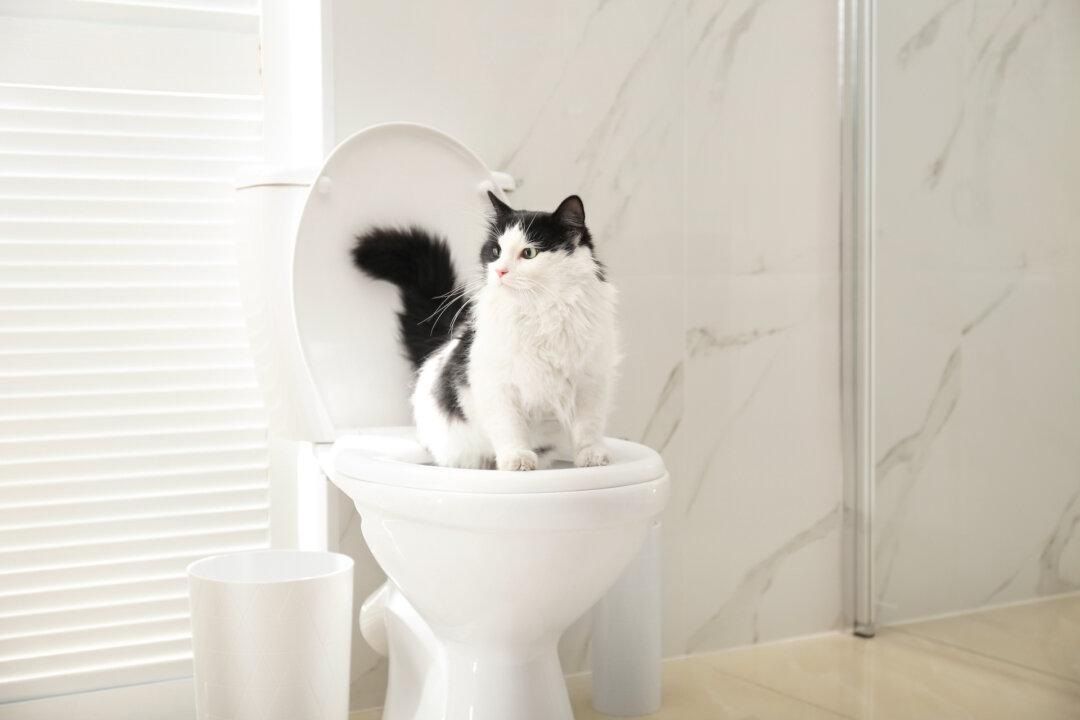
Q: I’m thinking about teaching Cameo, my newly adopted young calico cat, to use the toilet instead of a litter box. Are most people successful at toilet training their cats?
A: I don’t recommend toilet training cats for three reasons.
First, my mom told me that when she visited her aunt, who had toilet trained her cat, the toilet seat was often wet. Mom quickly learned to look before she sat.
Each time Cameo misses the toilet bowl, you, too, may discover an unwelcome surprise, especially if you visit the bathroom in the middle of the night.
The second reason I don’t advocate toilet training is that it’s an unnatural behavior for cats, so it’s likely to produce stress. In cats, stress often manifests as inappropriate urination.
Most cats dislike water, especially baths, so imagine how Cameo will feel if she slips into the toilet bowl while eliminating.

It’s very possible for Cameo to be so traumatized by having to use the toilet that she will urinate on the floor instead.
Or she may “hold it” too long, increasing her risk of urinary tract infection.
Third, if you make Cameo use the toilet, you'll lose an important way to monitor her health. Scooping her litter allows you to notice if she starts passing large quantities of urine, a sign of diabetes or kidney disease, or many small spots of urine, which can signal an infection. In addition, scooping her litter lets you recognize diarrhea or constipation.
Rather than train Cameo to balance on a toilet seat and urinate over a pool of water, offer her litter that’s similar to the soft, sandy soil cats are instinctively drawn to. Both of you will be happier.
Q: Major, my 10-year-old mixed-breed dog, suddenly started staggering around in circles like he was drunk. His head tilted to one side, and he vomited and refused to eat.
I rushed him to his veterinarian, expecting to be told he was dying, but the vet diagnosed a disorder called old dog vestibular syndrome. She prescribed motion sickness medication and said Major would be fine soon.
Did I do something wrong? Please educate me about this frightening condition.
A: Old dog vestibular syndrome develops when the balance apparatus deep inside one of the dog’s ears goes awry. While the cause is unknown, rest assured that you did nothing wrong. This condition is common in older dogs, and it resolves in a short time.
Clinical signs begin abruptly and include such poor balance that the dog may be unable to stand. Affected dogs may pace in circles, roll and have a head tilt.
If you look closely, you may see Major’s eyeballs move rhythmically from side to side or in circles, a condition called nystagmus (nis-TAG'-mus).
In addition, dogs with vestibular syndrome often experience vomiting, drooling and loss of appetite.
With medication to control the dizziness and vomiting, most dogs feel better within a few days to a few weeks. In some dogs, a subtle head tilt remains, especially when they’re tired.
Fortunately, the condition rarely recurs.
Celebrate Easter With Chocolate Bunny, Not Live One

Flat-Faced Breeds Are Prone to Health Problems

Toxic Mushrooms Resemble Harmless Varieties


IMAGES
VIDEO
COMMENTS
Motion sickness in cats is a common problem. While many dogs can be "trained" to comfortably ride in cars, it can be much more challenging for cats to overcome their anxiety. Most motion sickness in cats is caused by the stress and anxiety associated with travel. Cats that travel only once or twice a year (typically when visiting the ...
Motion sickness is fairly common in pet cats. Underlying stress is the main cause of motion sickness. If your pet shows any of the signs of motion sickness including drooling or crying you can try some behavioral desensitization to acclimatize your cat to travel. Speak to your veterinarian to help soothe your kitty's stresses.
Extra Tips: Place a blanket or shirt with a familiar scent on it within your cat's carrier. Your own unwashed shirt will work great. Spray Feliway in your cat's carrier or in the car. Feliway is a synthetic replica of feline pheromones, often used to reduce stress and anxiety in cats. Keep your car cool.
Reviewed/Revised Aug 2018. Motion sickness results in nausea, excessive salivation, vomiting, and occasionally other signs. Animals may yawn, whine, show signs of uneasiness or apprehension, or have diarrhea. Motion sickness is usually seen during travel by land, sea, or air, and signs usually disappear when the motion of the vehicle ceases.
Traveling with a cat prone to motion sickness can be a challenging endeavor, but by understanding the causes, recognizing the symptoms, and implementing preventive measures, you can significantly improve their travel experiences. Whether through stress management techniques, gradual desensitization, or the judicious use of medication, ensuring ...
There are several potential causes of motion sickness in cats. One possible cause of motion sickness can be emotional (behavioral), and linked to a bad travel experience in early life. Many cats feel insecure when taken out of their indoor environment infrequently. Diagnosis Once neurologic, behavioral and other causes of vomiting are ruled out ...
The cause of motion sickness in cats is often accredited to stress and anxiety. In some cases, a negative early experience with traveling can cause a cat to suffer from frequent bouts later in life. Additionally, indoor cats might feel anxious and uneasy when they are taken outside for travel purposes.
This is why it is important to prevent and manage motion sickness in cats. Motion sickness occurs when constant motion disrupts balance and equilibrium. The stress and anxiety from traveling usually cause motion sickness in cats. Cats that are not used to traveling by car may suffer from motion sickness as a result of fear, anxiety or discomfort.
Motion sickness in cats is a common issue many cats face, especially when they aren't used to traveling. So how can you keep your furry friend from making your car their personal barf bag? Does Your Cat Get Motion Sickness? If you don't bring your cat on many car rides, they likely stress out when the time finally comes.
What is motion sickness in cats? Motion sickness is a common occurrence in many cats. There can be several causes, but the most common cause of motion sickness in cats is anxiety and stress associated with travel. If your cat experiences this, you may notice the following symptoms: fast breathing or panting; excessive lip licking and drooling
How to Deal with Cat Travel Sickness. Traveling with a cat can be an exciting adventure, but some cats may experience travel sickness, which can make the journey uncomfortable for them. To ensure a stress-free and enjoyable trip for your feline friend, here are some tips on how to deal with cat travel sickness. Creating a Calm Environment
Motion sickness is characterized by signs referable to stimulation of the vestibular and autonomic nervous systems, including excessive salivation and vomiting. Affected animals may also yawn, whine, or show signs of uneasiness and apprehension; severely affected animals may also develop diarrhea. Motion sickness is seen during travel by land ...
Motion sickness is the feeling of nausea during land, sea, or air travel caused by excessive or unpredictable movement. Symptoms of motion sickness in cats include nausea, salivation, and vomiting. Symptoms of motion sickness stop following cessation of the motion trigger. Symptoms are common in cats during travel but it is unknown if cats are ...
Neurokinin-1 (NK1) Receptor AntagonistsMaropitant (Cerenia) affects NK1 receptors in the GI tract, CRTZ, and vomiting center; at high doses, maropitant also prevents vestibular-induced travel sickness in dogs and cats. 5-7 Substance P is a neurotransmitter that is involved in the regulation of mood, anxiety, stress, respiratory rhythm, pain ...
Car sickness in cats is common. You can treat motion sickness in cats with over-the-counter meds for anti-nausea for cats and prescription anxiety meds. ... One reason is "the stress and anxiety many cats experience when traveling by car, as they generally don't do it often," says Megan Conrad, BVMS, a veterinarian with Hello Ralphie ...
Motion sickness can occur in any cat, regardless of age, breed, or sex. However, it typically affect kittens and those who may not be used to traveling as much. What is motion sickness? There are two main causes of motion sickness in cats. The first one relates to balance. There is a balance system in the inner ear that communicates with their ...
Yes. You can actually give your cat medicine to treat motion sickness before going on a trip. You can use an over the counter medicine like dramamine from amazon. A safe dose to give your cat is 12.5 mg. These tablets are dosed at 50 mg per tab, and have a score down the middle for easy cutting.
Many cats dislike care travel due to the random movement, loud noises, and motion sickness. 02. You can make car travel less stressful for your cat by using pheromones or calming sprays , choosing an appropriate carrier, and reducing loud noises in the car. 03. Speak to your veterinarian about light sedatives, calming medications, and anti ...
Traveling with cats can be a daunting task, especially if your feline companion experiences anxiety or motion sickness. As a responsible pet owner, it's important to prioritize your cat's comfort and well-being during travel. In this ultimate guide, we'll explore the challenges cats face when traveling and provide practical tips to ease ...
Immensely. The Washington State Ferry System used have an onboard service called "Balance Cats" where a ferry rider could ask the Purser for a cat to sit on their laps during their ferry ride. The theory was that, because cats are agile and always land on their feet, they would give riders who suffered from sea sickness a sense of balance and ...
Our attention is focused at development of consistent type in Siberians. The Siberian breed is still very young, and so, the principle that "first to build the house, next to paint it" should be the hallmark of current breeding of Siberian cats. And "wild" colors and patterns are the best companions to the overall appearance of a ...
Specialization of the nursery is the breeding of Siberian cats with high breed data. On the purchase of Siberian kittens from our kennel, please call the contact number + 7-926-780-80-18 or + 7-985-895-48-85, or you can also apply by e-mail [email protected]. In addition, we can always get advice on the care and maintenance of cats and cats ...
Pet fee: $125. Pets allowed: Dogs, cats, birds (with the exception of flights to or from Puerto Rico and the U.S. Virgin Islands) or rabbits (with the exception of flights to or from Puerto Rico ...
Yes, cats can contract bird flu if they interact with infected birds. Bird flu is primarily considered a transmission risk between wild birds and domestic birds; the recent presence of bird flu in ...
• Advice and assistance in adopting a cat or dog • Assistance with exporting and importing pets from and to Russia (airport meetings, export / import customs clearance, pet travel advice, advice on making travel arrangements for pets, etc.) You can contact Yuri & Valeria at 200-03-88 (home) or 8-2-906-25-10 (mobile).
From season 2 episode 4 "48 hours in Moscow": Richard Ayoade takes another 48 hour break, this time to Moscow with Greg Davis.Subscribe here to get your Rich...
The second reason I don't advocate toilet training is that it's an unnatural behavior for cats, so it's likely to produce stress. In cats, stress often manifests as inappropriate urination ...